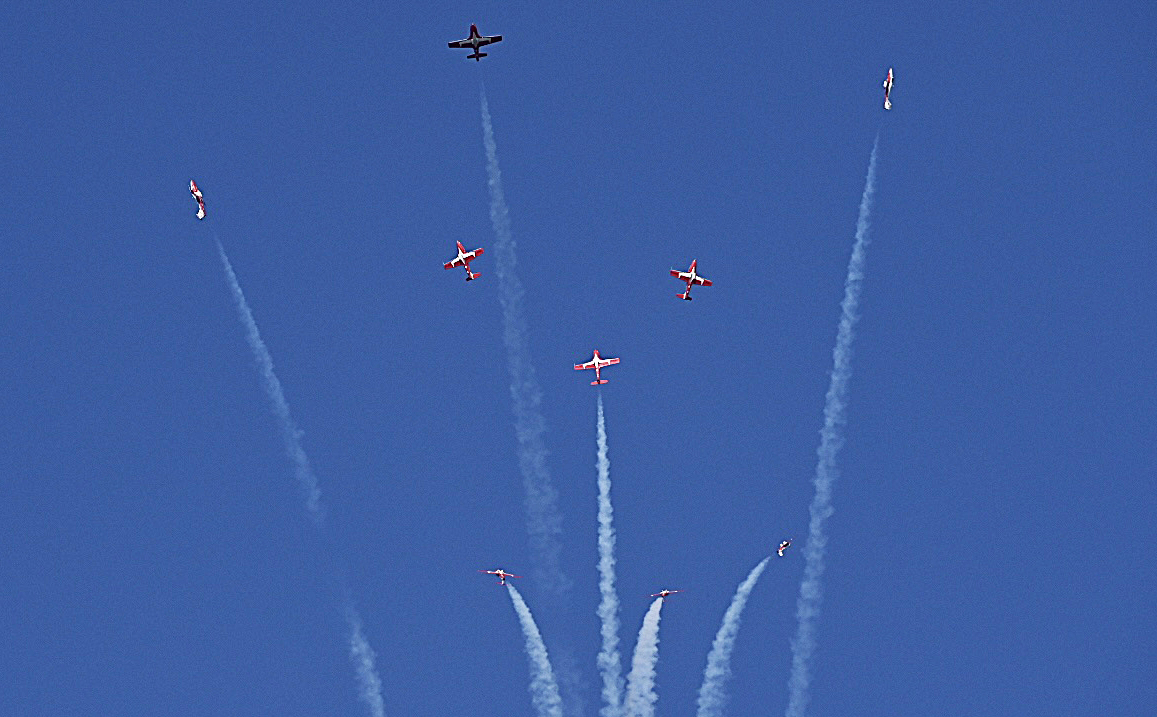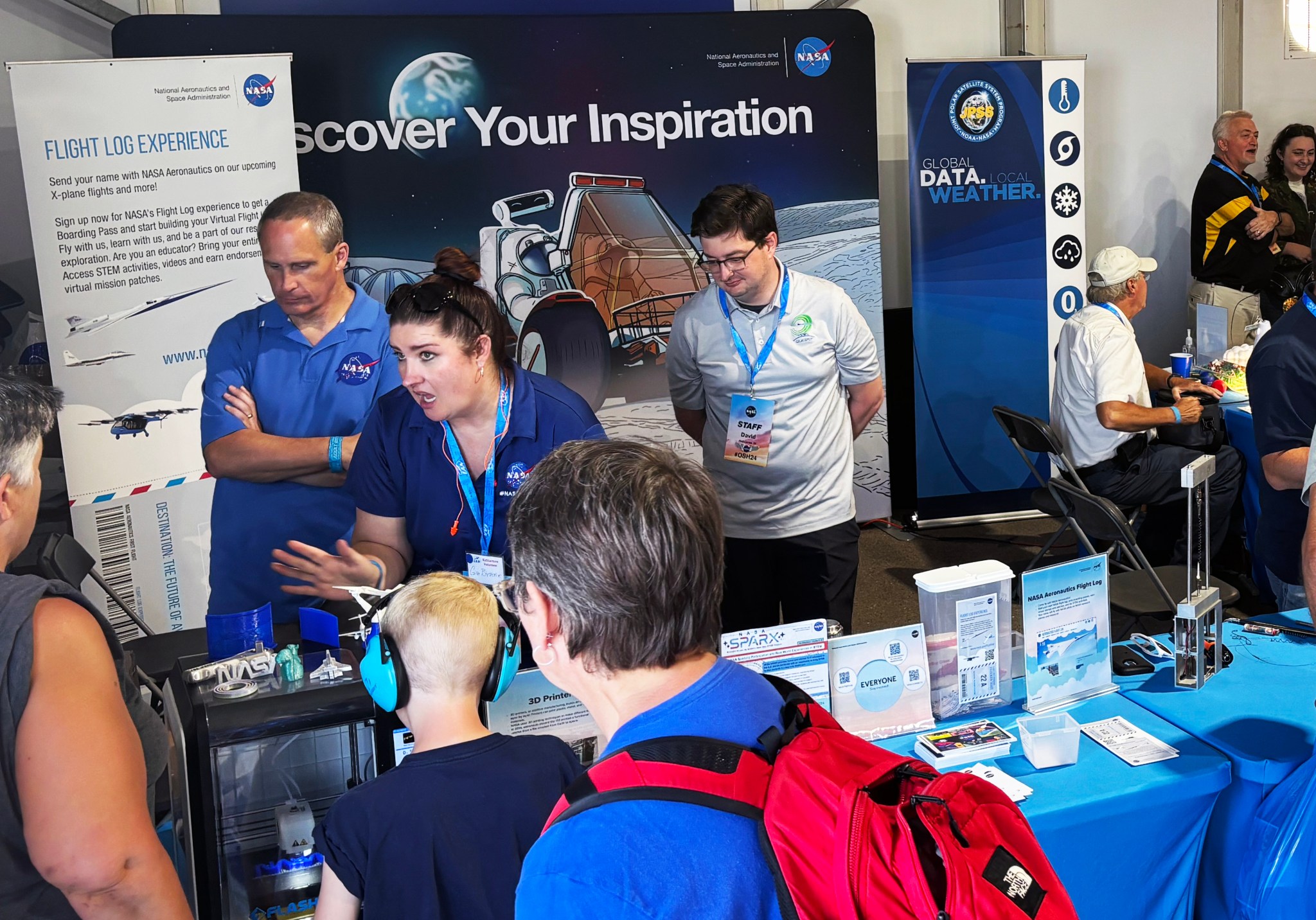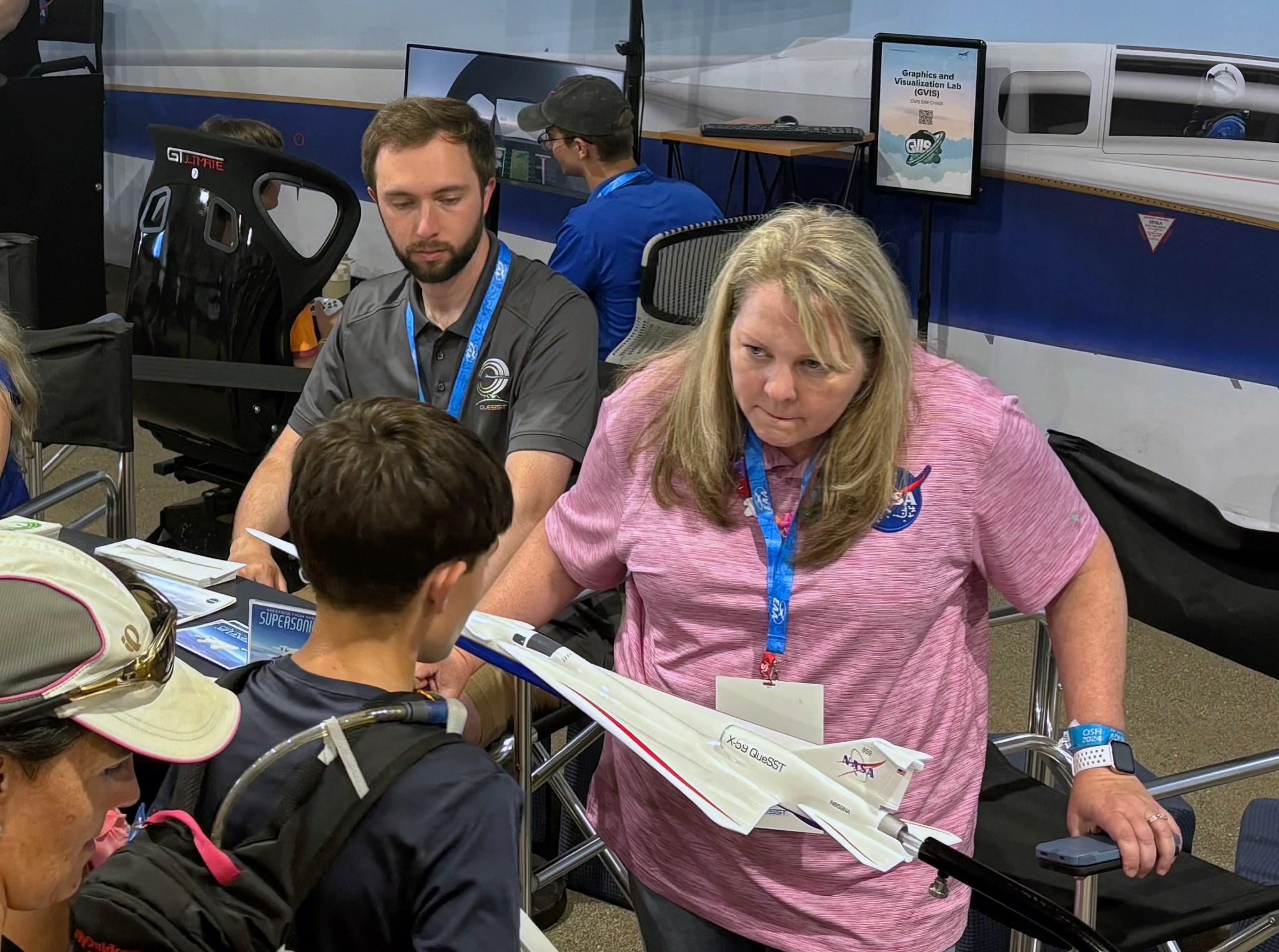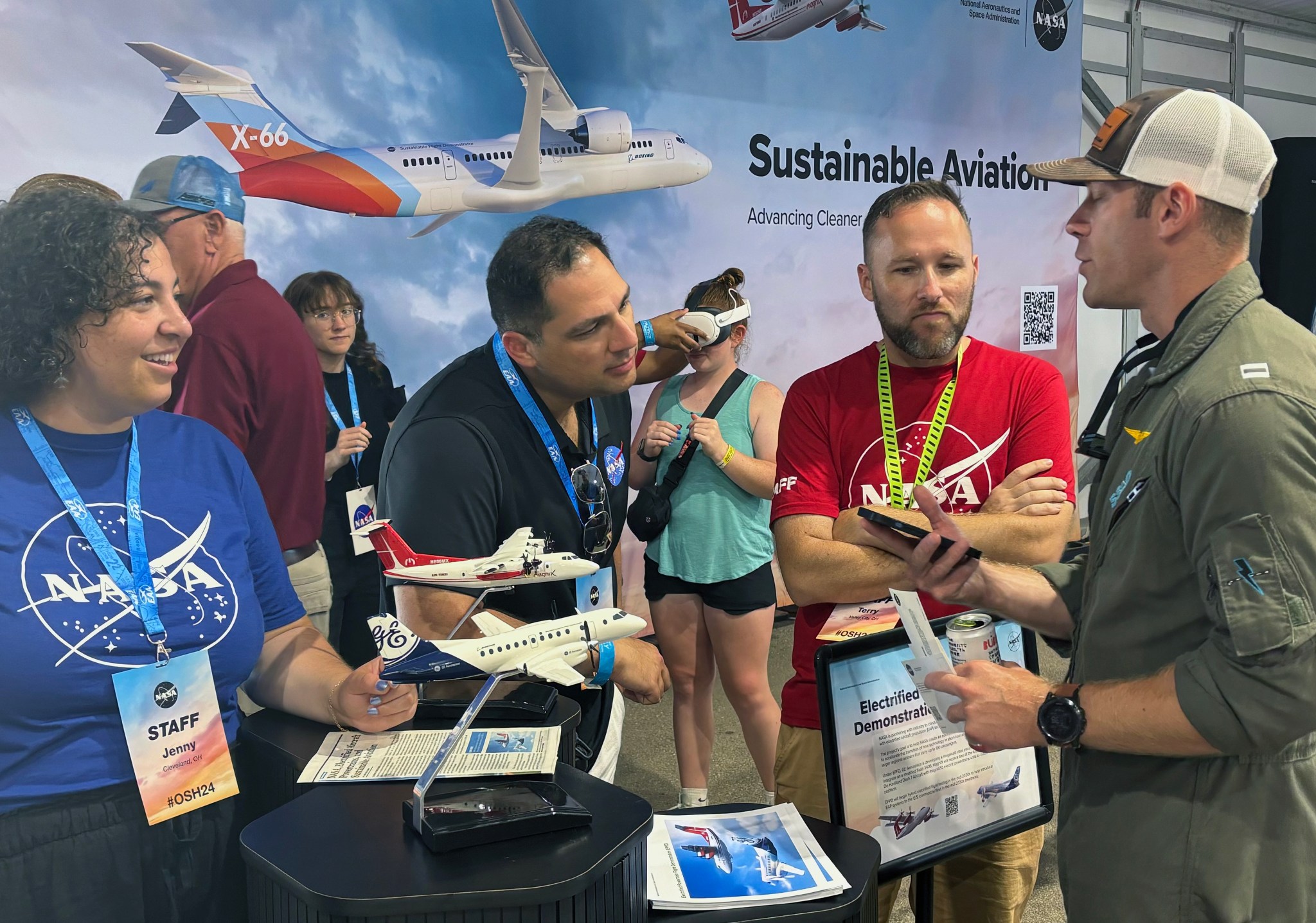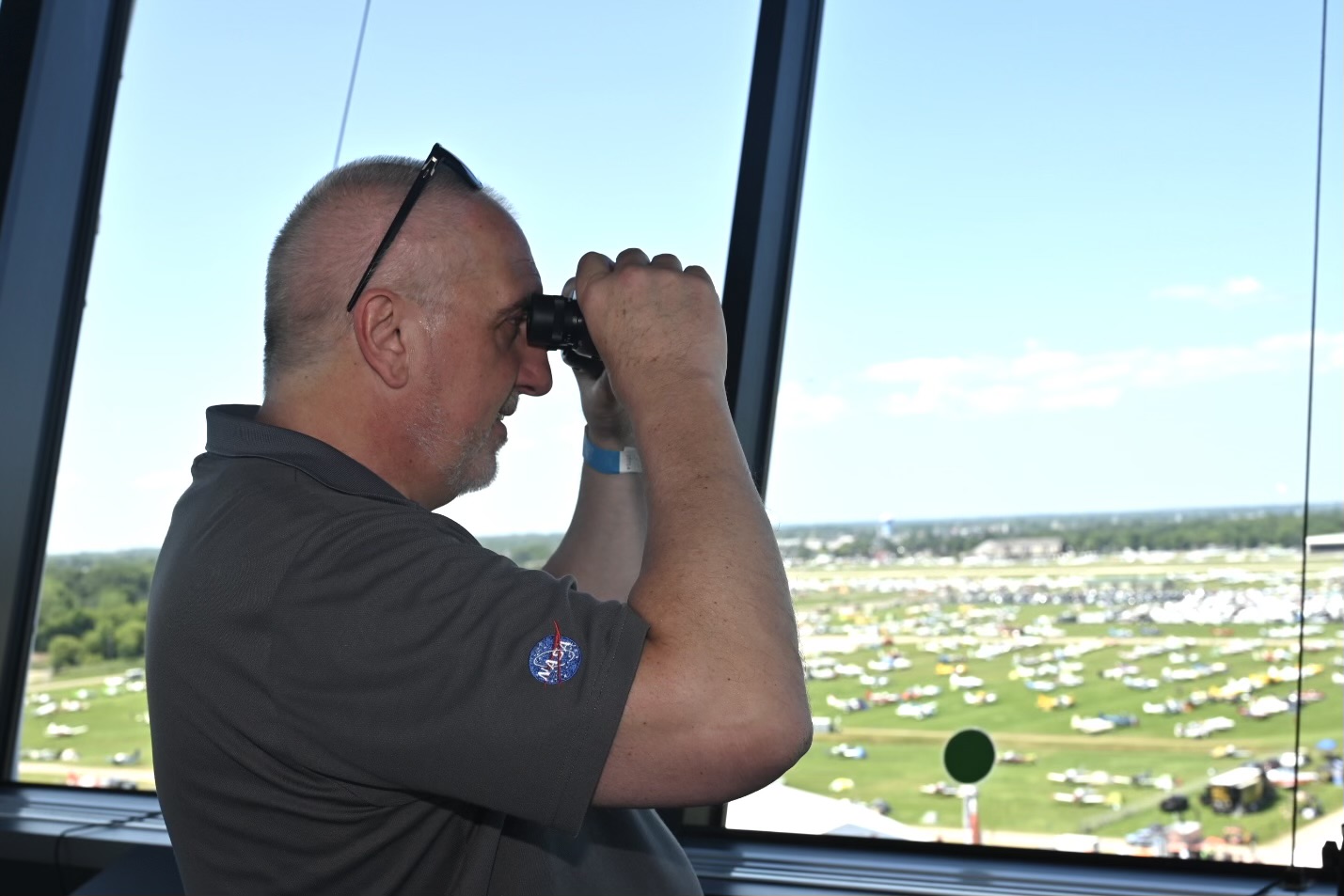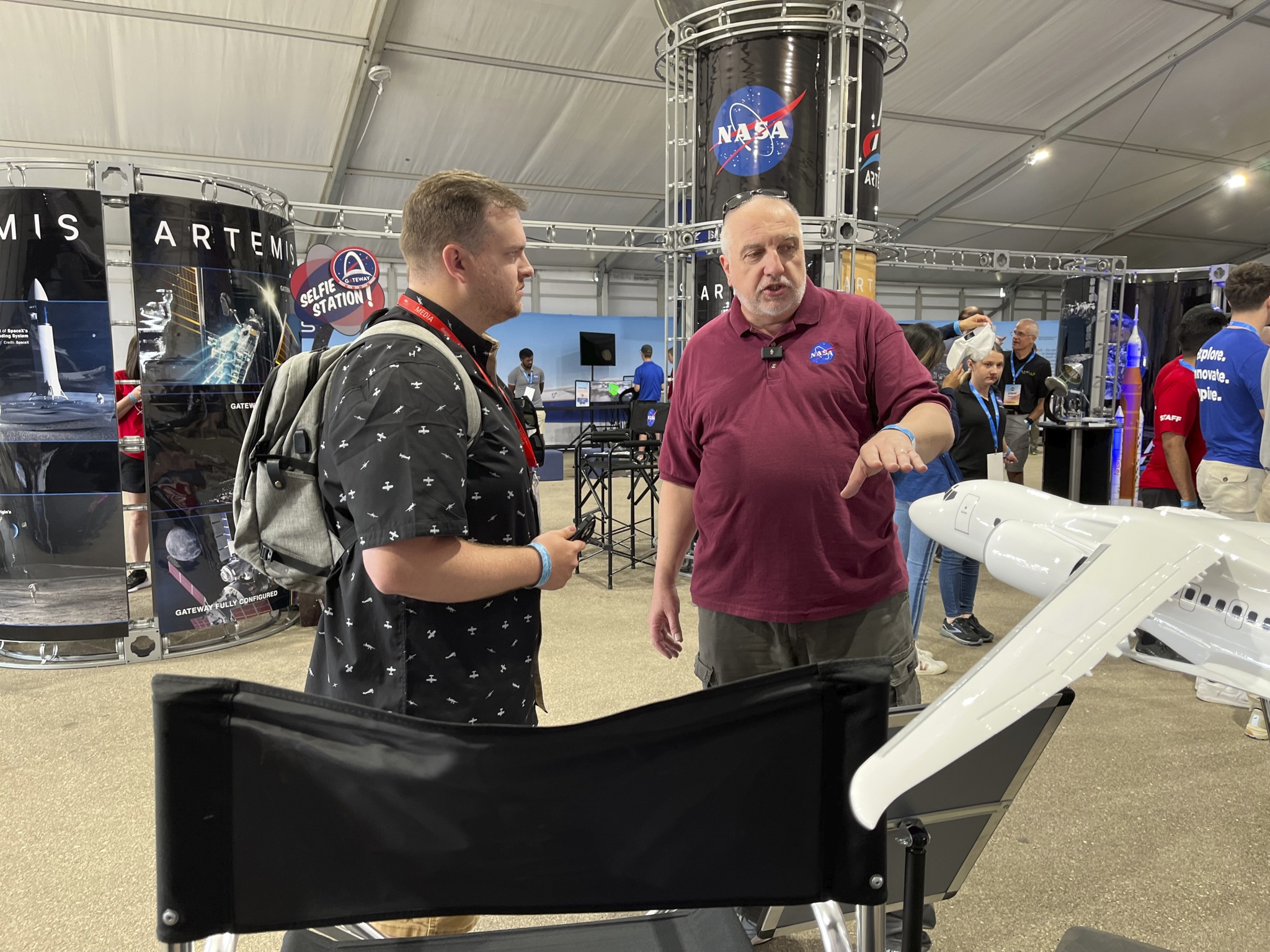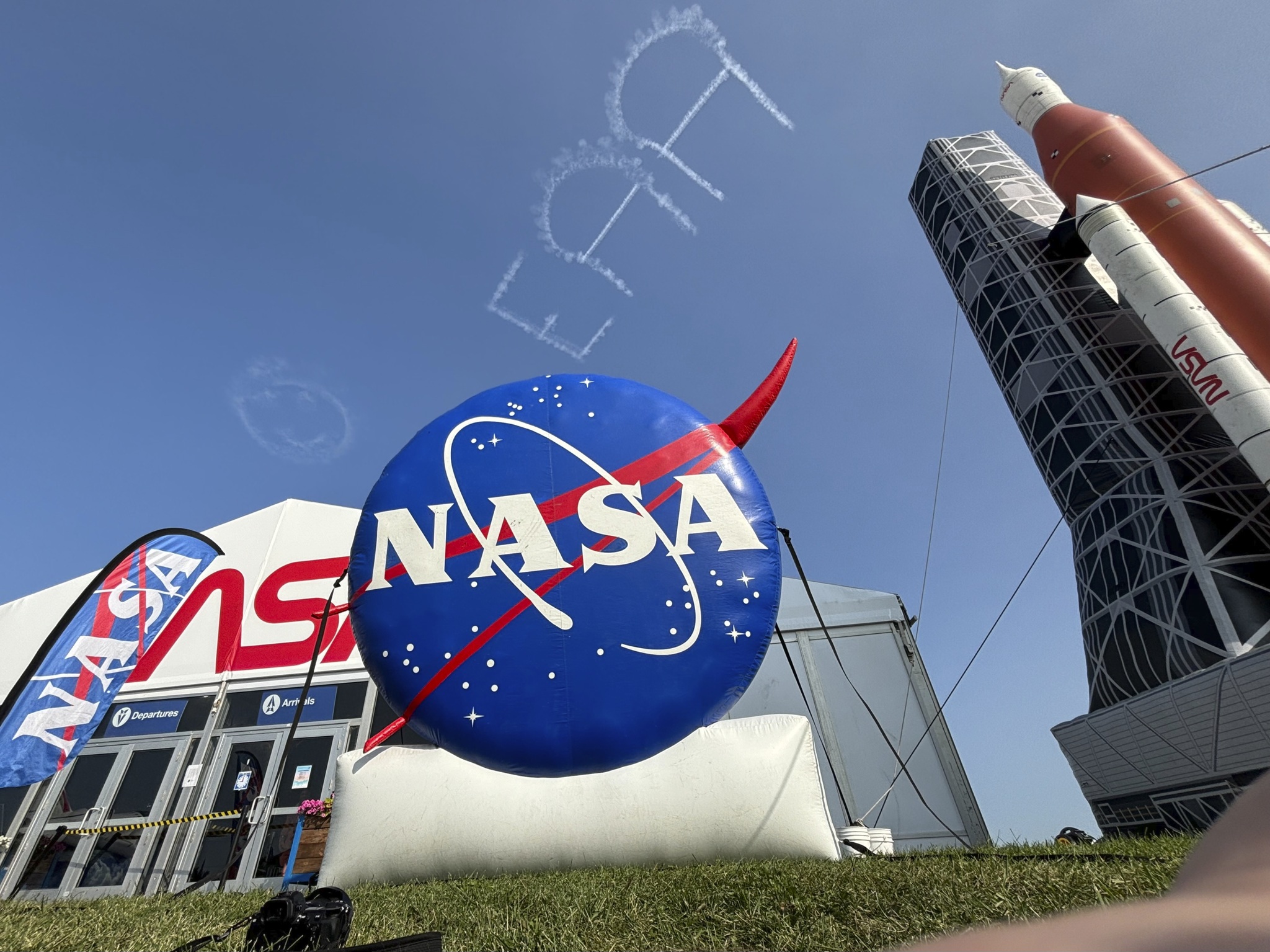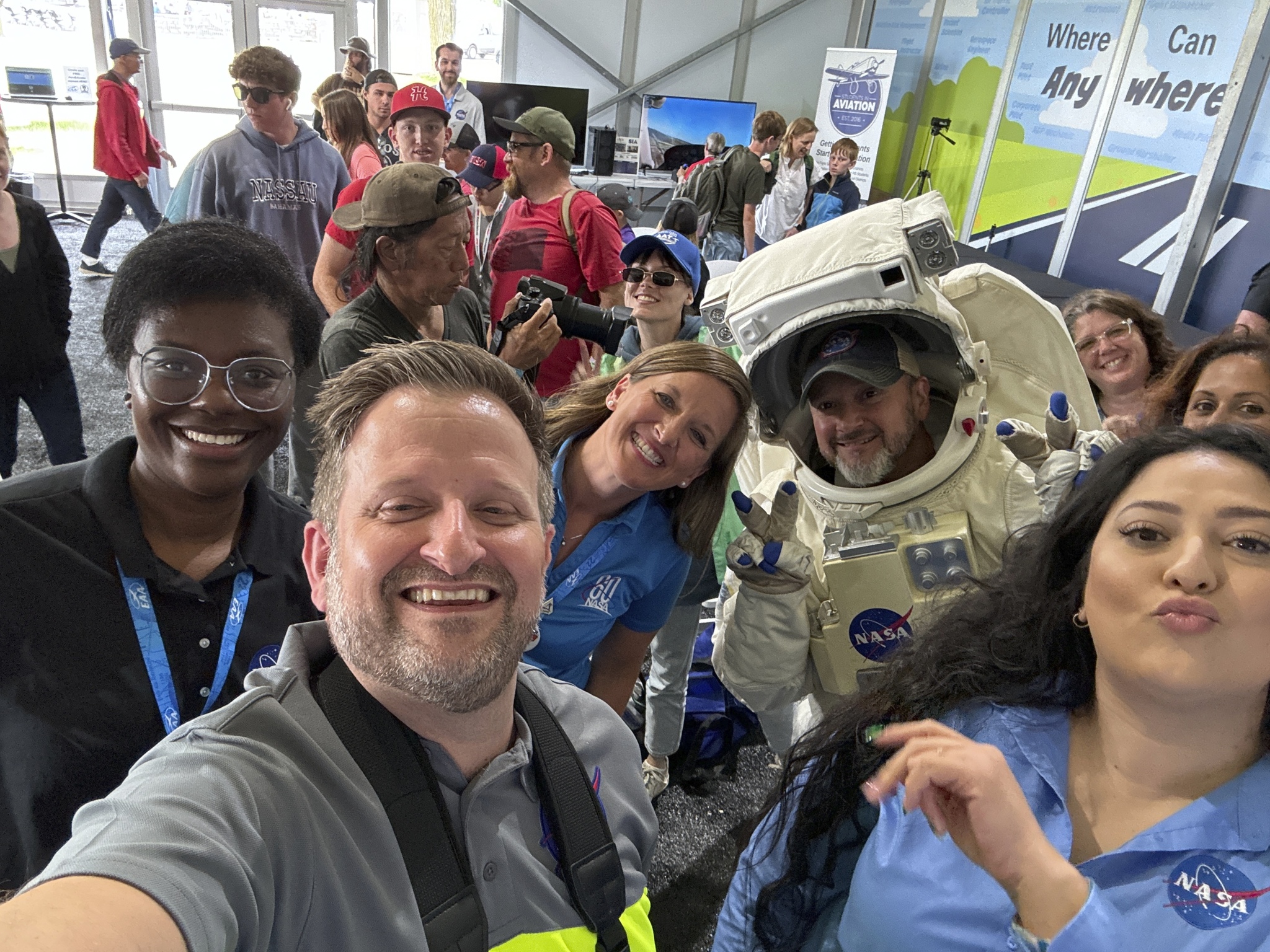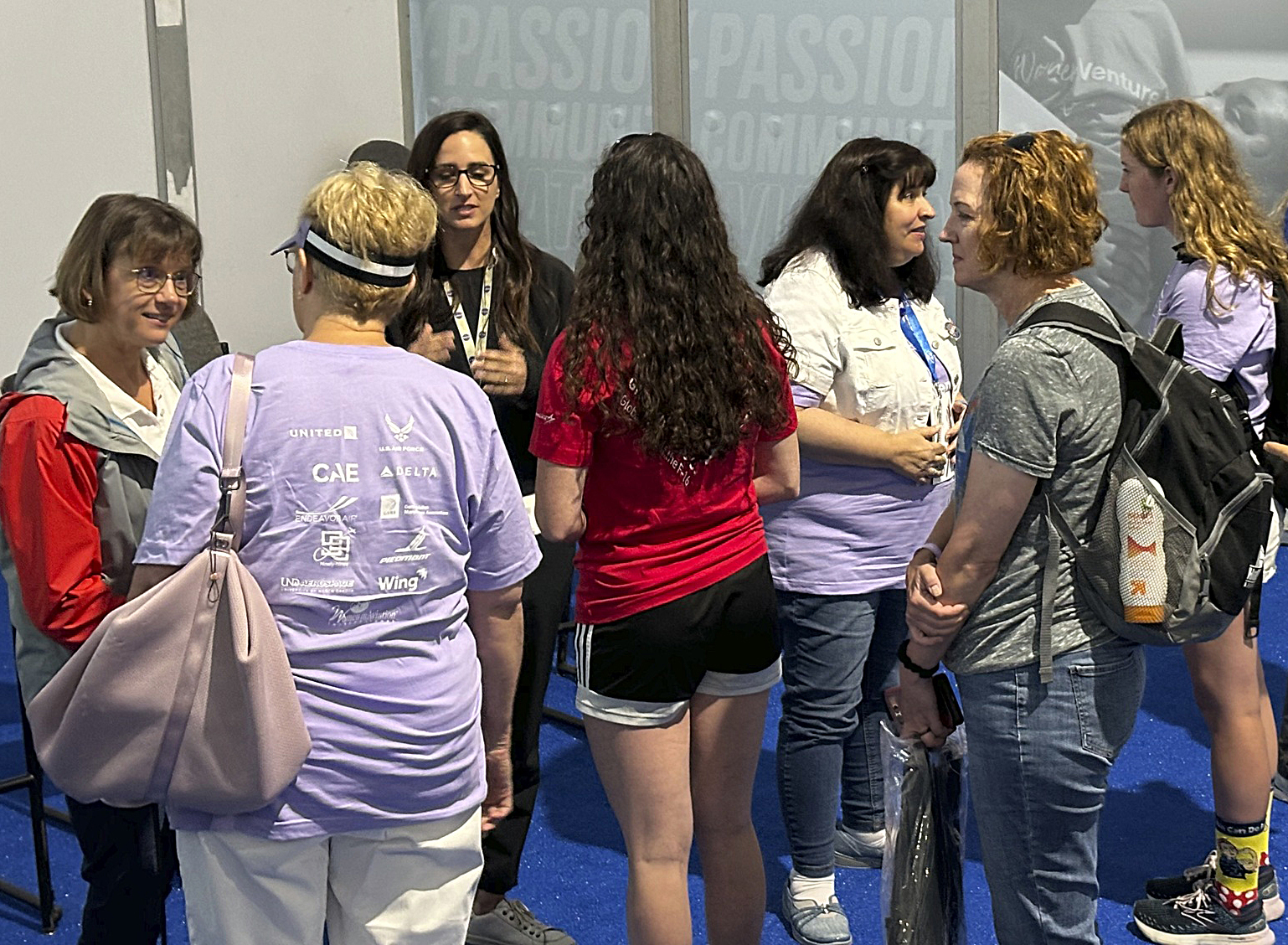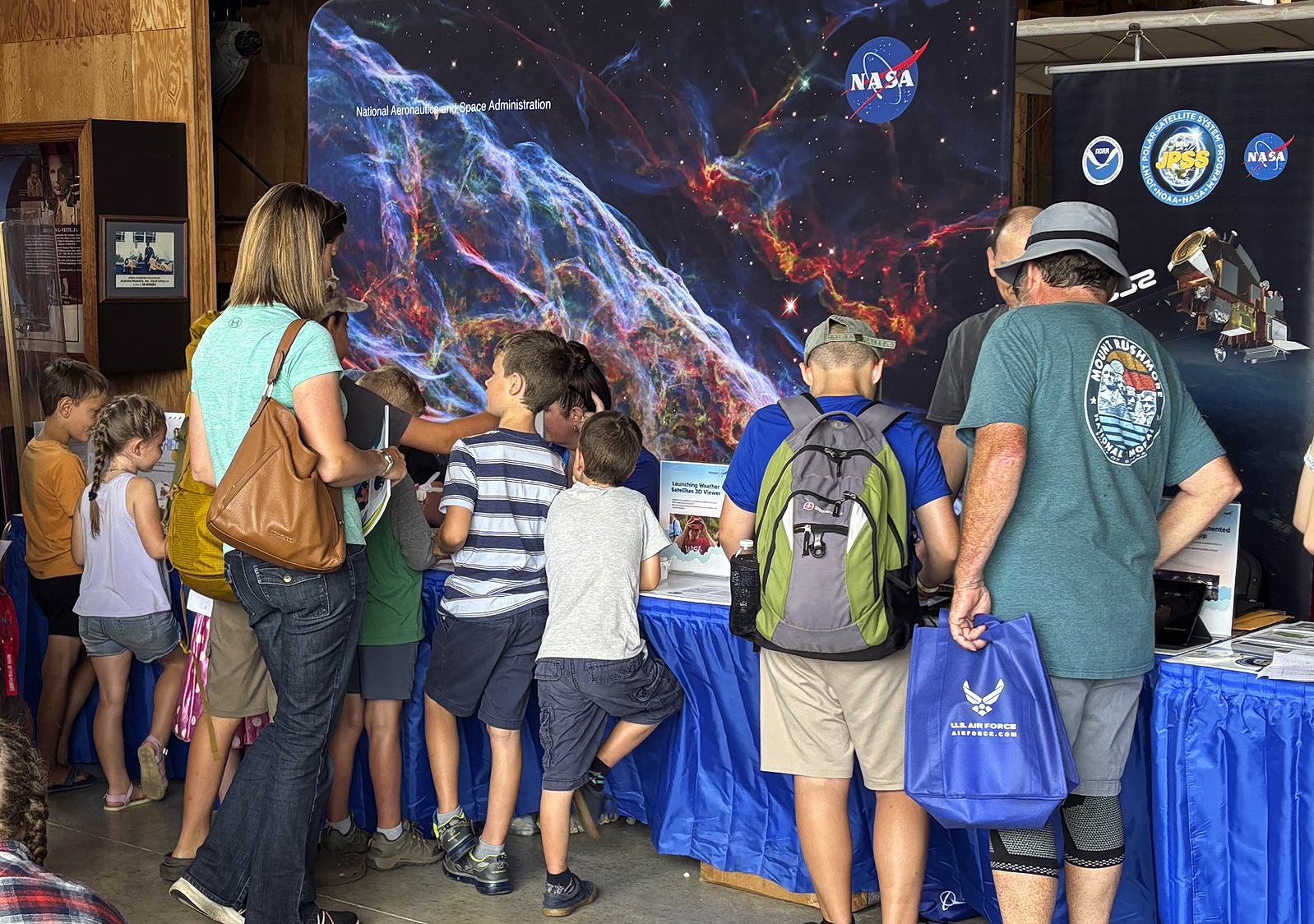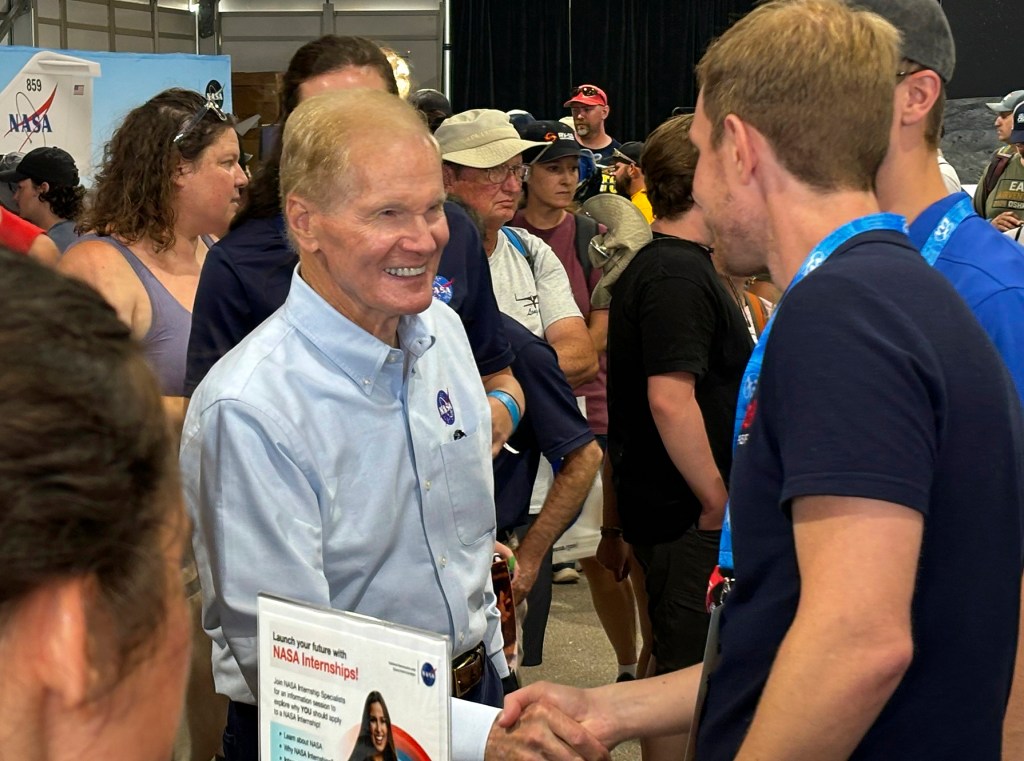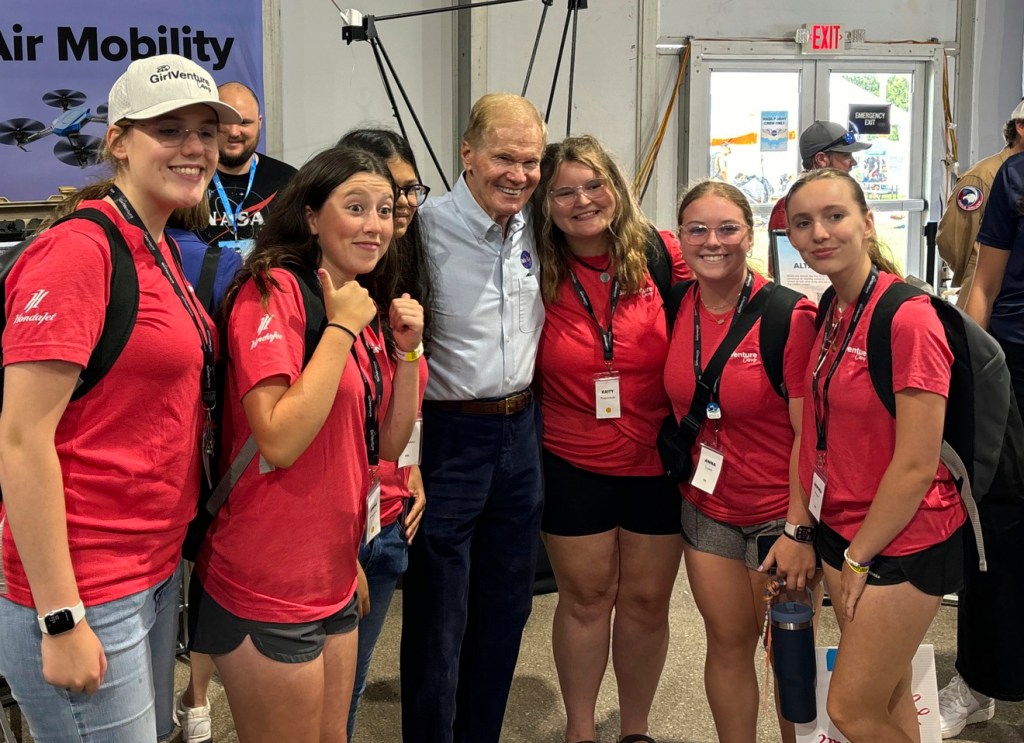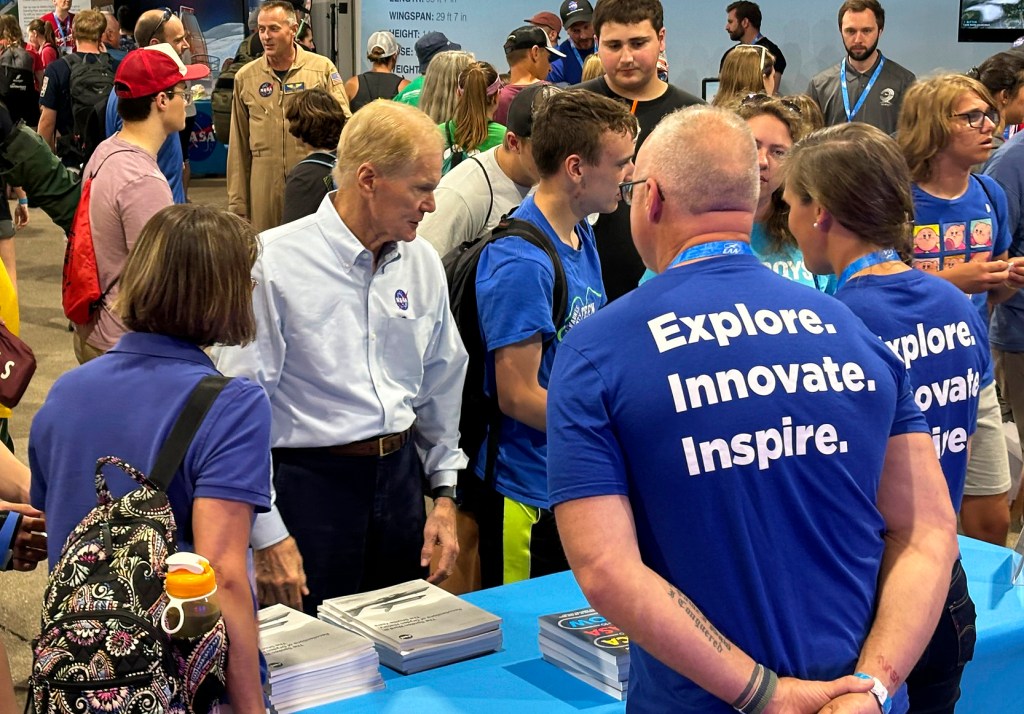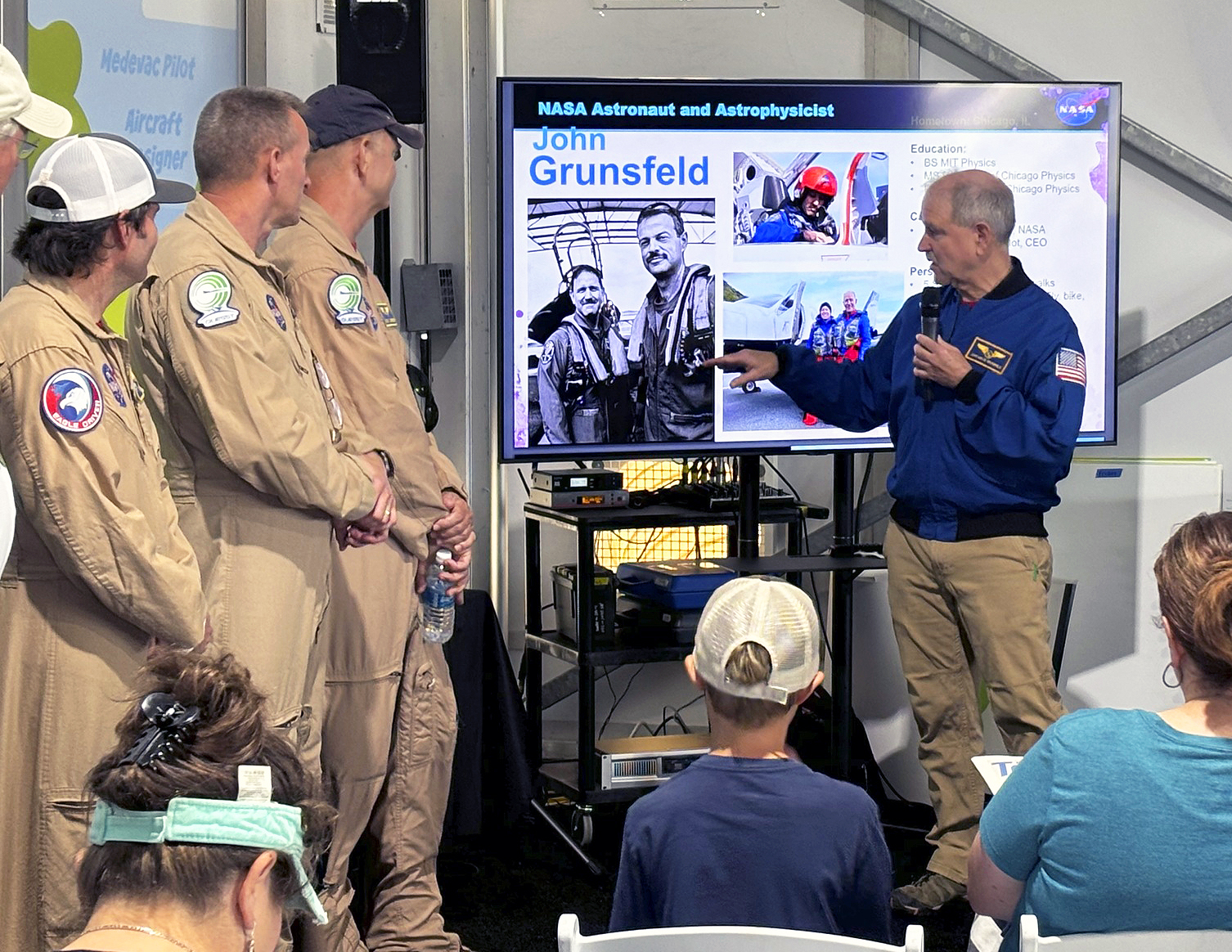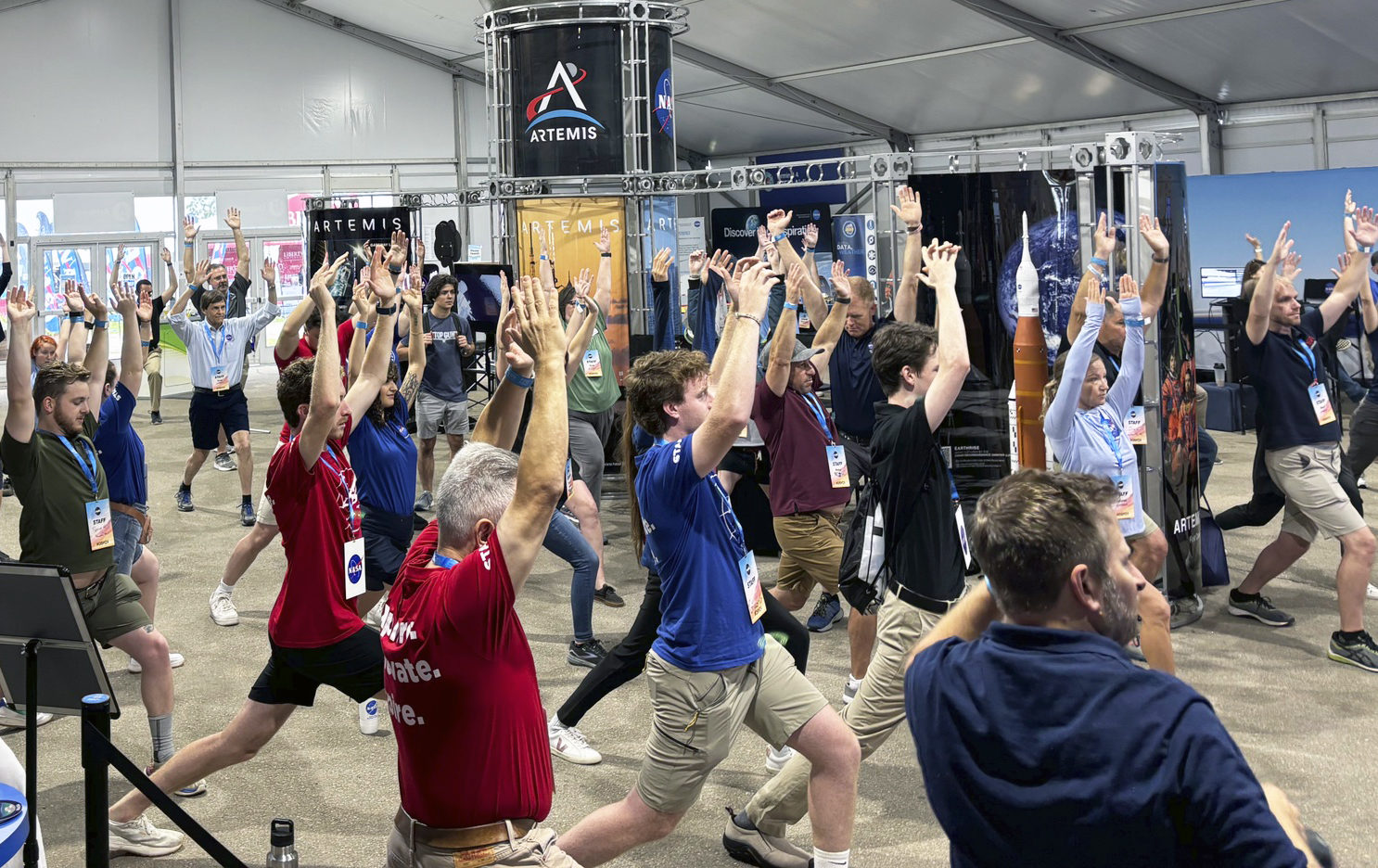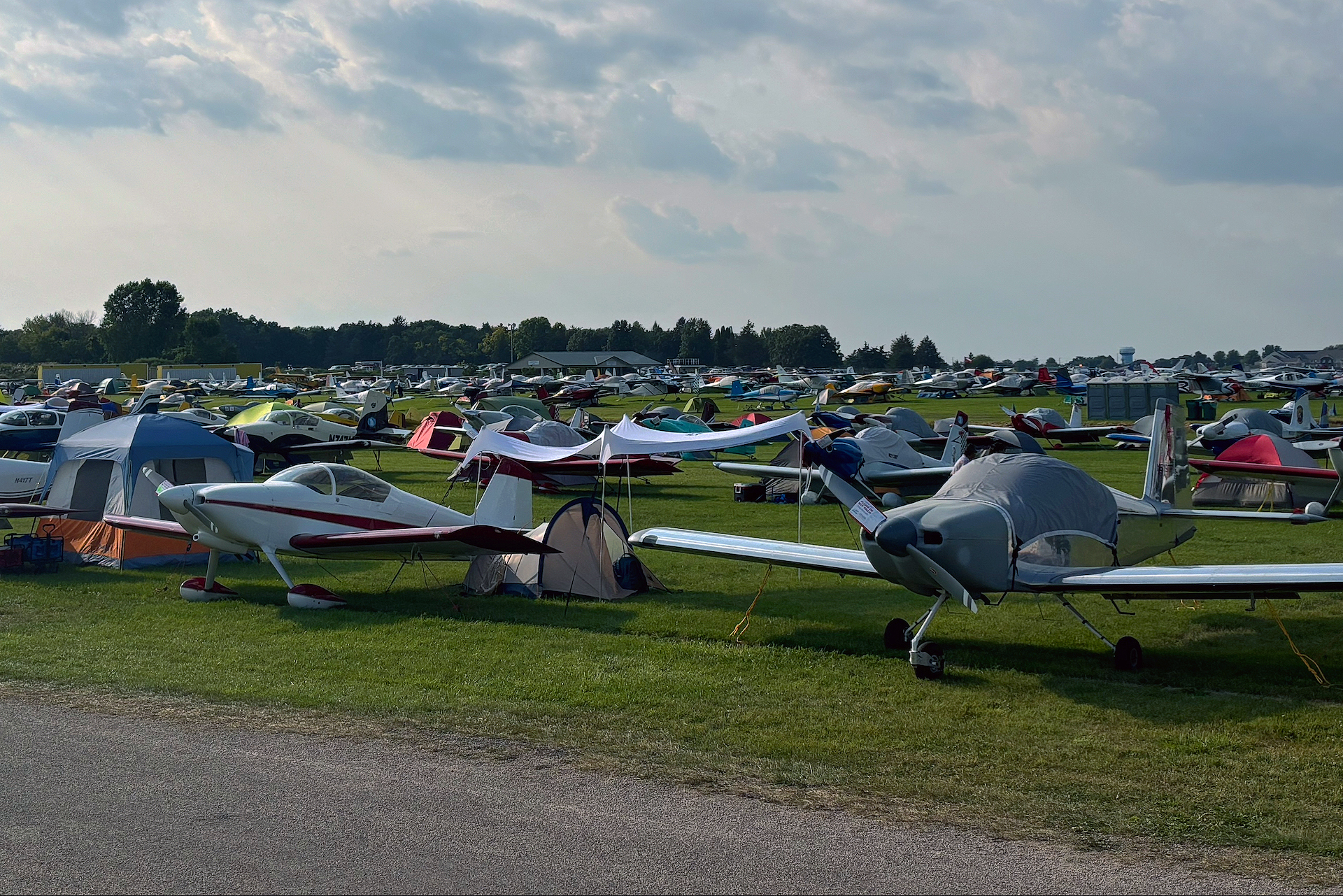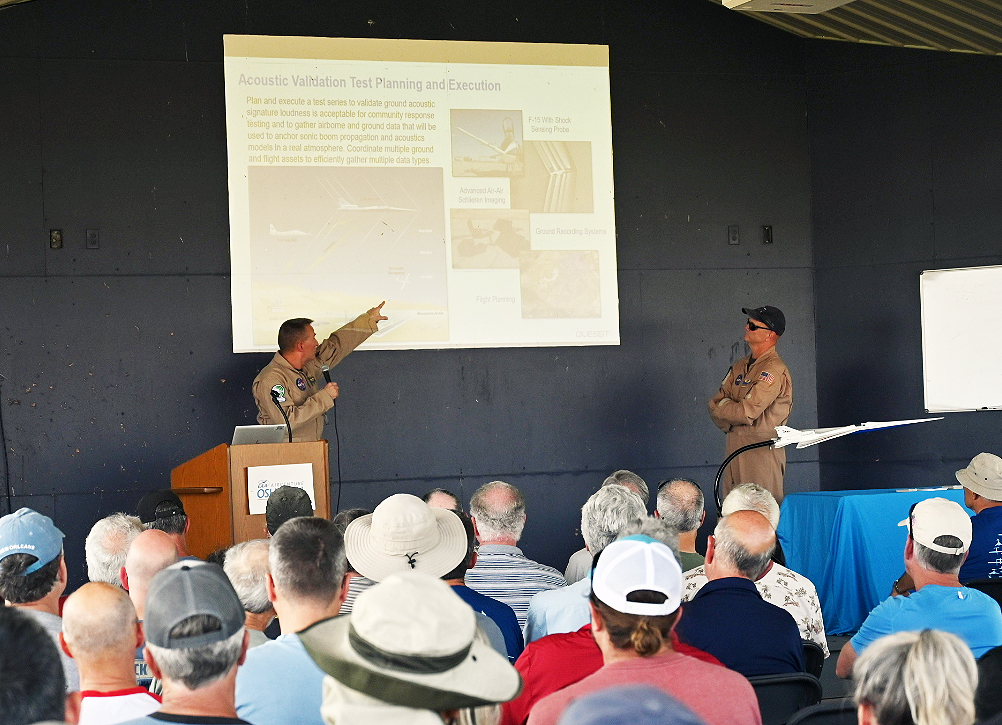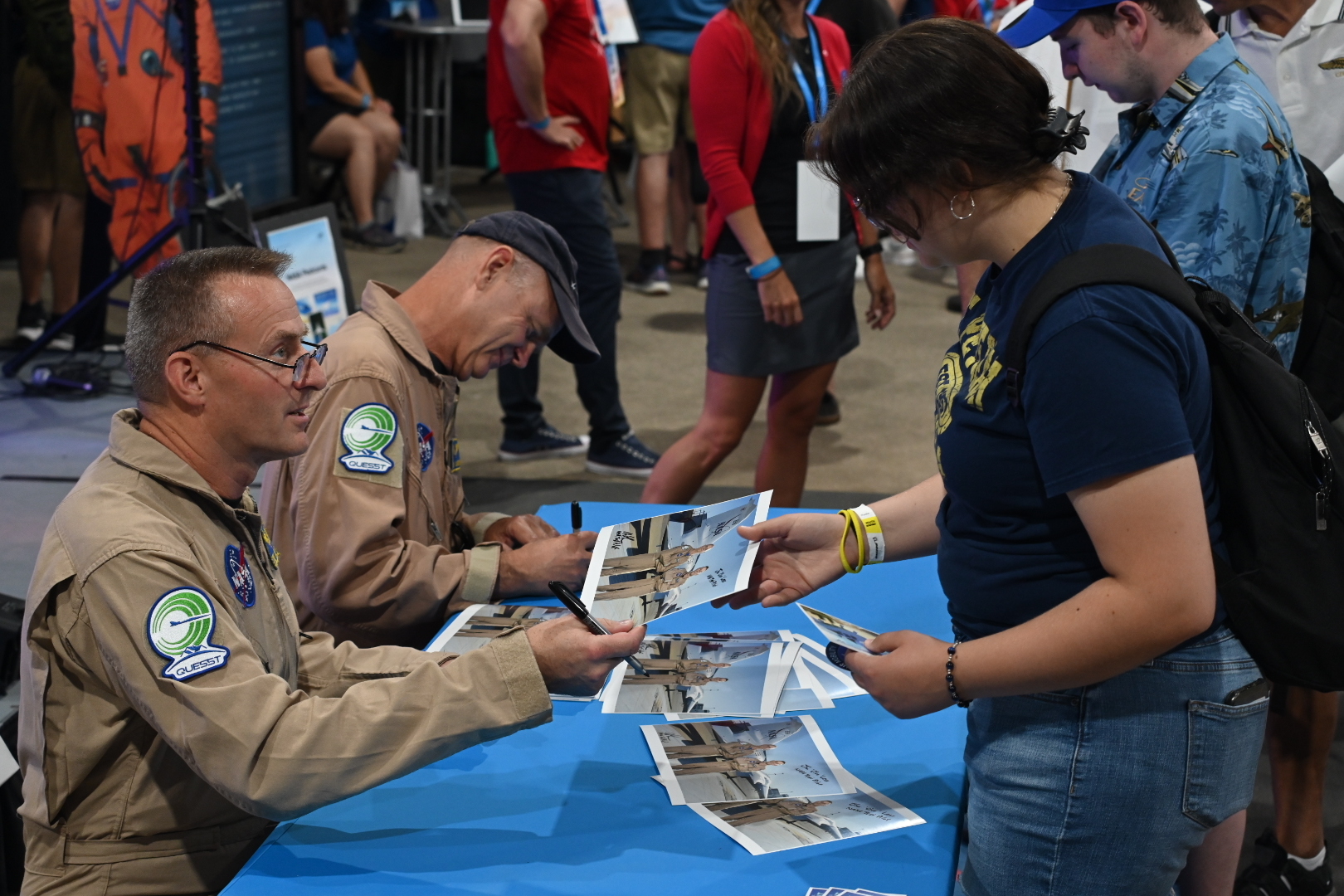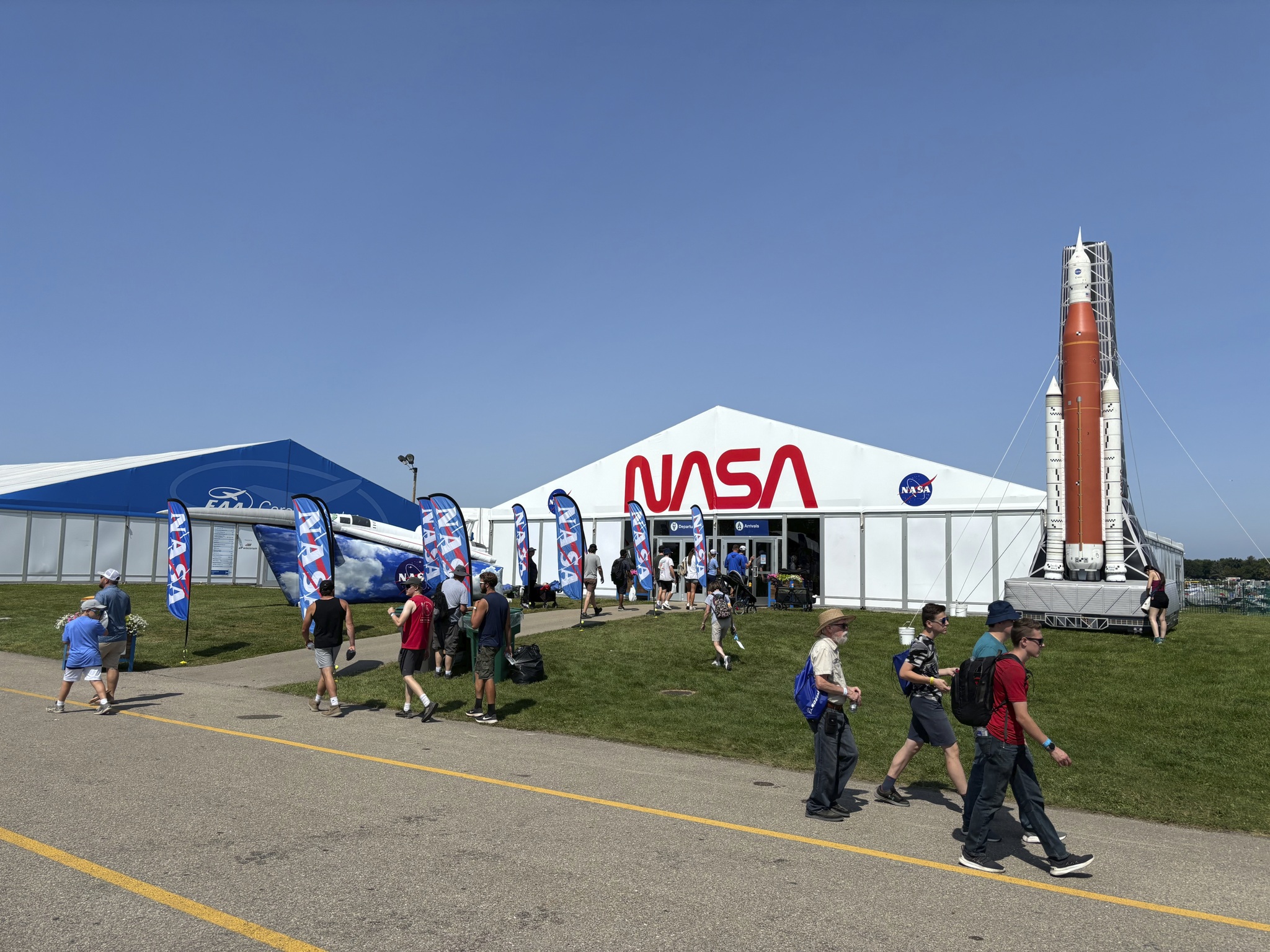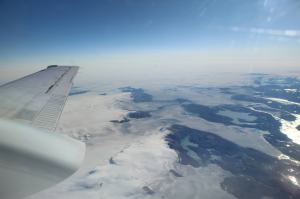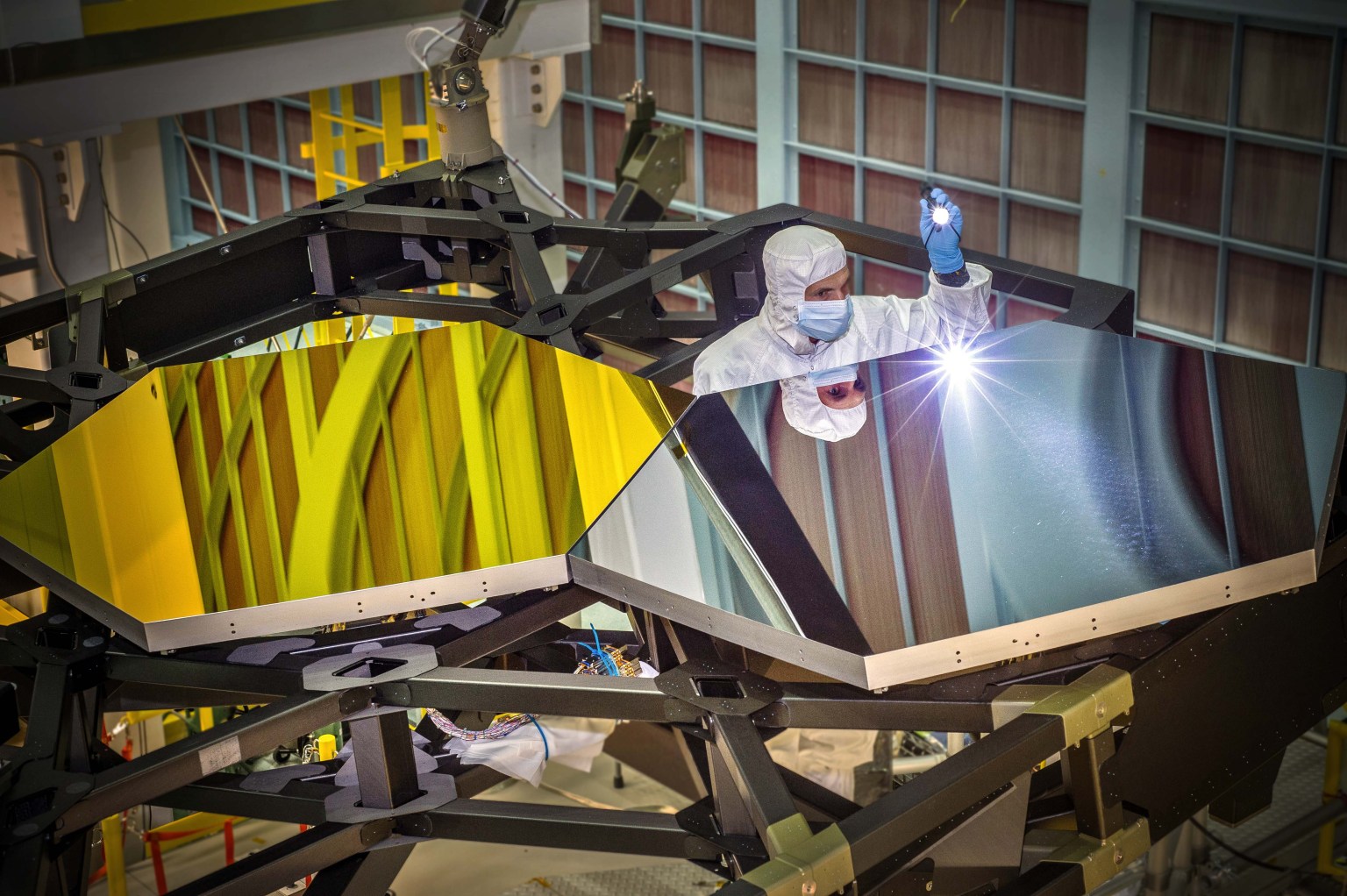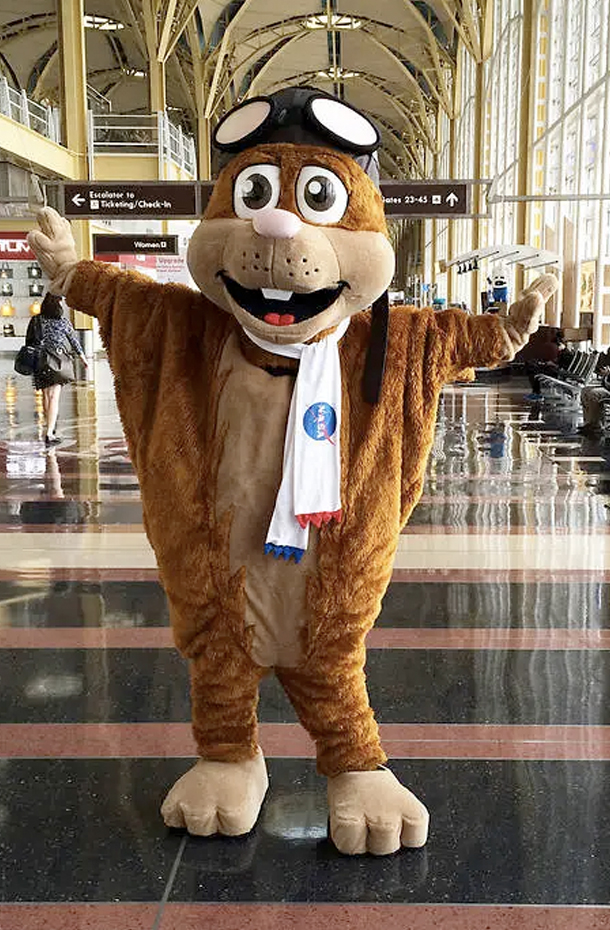Welcome to NASA Aeronautics’ live update page with news about NASA events and other festivities taking place throughout the week at EAA AirVenture Oshkosh 2024, which we simply call Oshkosh.
The End of the Runway
Saturday, July 27 at 6 p.m. EDT
With the show coming to a close tomorrow, our live coverage of NASA’s presence at EAA AirVenture Oshkosh 2024 now comes to a close. It’s been our privilege to bring to you a taste of what it’s like to be here, and to share with you NASA’s transformational vision for the future of aviation – one that is cleaner, safer, faster, and quieter.
In the words of Irving Berlin:
Blue days, all of them gone
Nothing but blue skies from now on
— John Gould
Terminal 4: STEM Airlines
Saturday, July 27 at 5 p.m. EDT
Finally, arriving at Terminal 4, NASA Pavilion visitors of all ages can play with and learn from some hands-on, educational activities, discover more about STEM education and careers, and see some innovative NASA research on display – such as a shape memory alloy presentation.
We hope you enjoyed this brief tour of the NASA Pavilion! Remember, the show ends tomorrow afternoon, so if you’re here in person, be sure to stop by to experience NASA’s flight research for yourself.
— John Gould
Terminal 3: Supersonic Flight
Saturday, July 27 at 3 p.m. EDT
Rounding the corner to Terminal 3, visitors to the NASA Pavilion are greeted by a huge wall graphic depicting the uniquely shaped supersonic X-59 aircraft.
The aircraft is the centerpiece of NASA’s Quesst mission, which has designed the X-59 to show an aircraft can fly faster than sound without generating loud sonic booms. The public’s reaction to the aircraft’s quieter sonic “thumps” will be shared with regulators, who can then consider writing new rules to lift the ban on supersonic flight over land.
At Terminal 3, audio headphones allow visitors to hear the difference between a sonic boom and a sonic “thump.”
There also is a simulation of the X-59 flying along, in which visitors sit in a haptic chair and fly themselves around the aircraft while viewing different types of imagery such as Schlieren and computational fluid dynamics.
— John Gould
Terminal 2: Air Taxis and Drones
Saturday, July 27 at 1 p.m. EDT
Moving to Terminal 2, visitors to the Pavilion learn about NASA’s leading role in Advanced Air Mobility.
Using drones and other new types of uncrewed aircraft, this air transportation system of the future will include low-altitude passenger transport, cargo delivery, and public service capabilities.
This terminal has a unique virtual reality experience involving flying onboard an air taxi. The experience showcases how subjects like autonomy, detect and avoid, and air traffic management may work in the future to make Advanced Air Mobility possible.
— John Gould
Terminal 1: Sustainable Aviation
Saturday, July 27 at 11 a.m. EDT
Inside the NASA Pavilion, our aeronautics research is organized into four “terminals,” where Oshkosh attendees can meet research experts, learn from our communicators, view displays, and engage in interactive exhibits.
Terminal 1 is for Sustainable Aviation.
Here, visitors can learn about how NASA is working with others to achieve net zero greenhouse gas emissions by 2050 thanks to new green aviation technologies. These include innovative aircraft shapes, electrified propulsion, and others intended to make flight more sustainable.
Visitors get to see a model of the X-66 sustainable flight demonstrator aircraft, models of the two aircraft being modified for use in the Electrified Powertrain Flight Demonstration project, and more.
— John Gould
Day 6 Arrives
Saturday. July 27 at 9 a.m. EDT
Good weekend morning from the entire NASA Aeronautics crew.
We like to say “NASA is with you when you fly,” and we’ve certainly been with you all week at Oshkosh, trying to give you a sense of what’s happening even if you couldn’t make it there in person.
Although EAA AirVenture Oshkosh 2024 doesn’t officially end until tomorrow, this will be the last day we will be providing live updates from our NASA Pavilion on the grounds of Wittman Regional Airport.
With a light day of NASA-related scheduled events, our writer John Gould is going to give you an up close and personal look inside the NASA Pavilion, taking you from exhibit to exhibit and explaining the work we’re doing to transform aviation for the 21st century.
We hope you enjoy the tour.
— Jim Banke
Friday Night Farewell
Friday, July 26 at 7 p.m. EDT
It’s time to say good night from Oshkosh as the work week comes to a close and the weekend beckons.
If you happen to be present at the air show tonight, don’t miss the NASA panel at the Theater in the Wood venue. The topic will be the Artemis II mission to return humans to lunar orbit for the first time since 1972.
The air show officially wraps up on Sunday and the NASA Pavilion will remain open for visitors both Saturday and Sunday. Our live updates on this page will continue through tomorrow afternoon and then wrap up for the event.
See you tomorrow.
— Jim Banke
More NASA Social Media
Friday, July 26 at 6 p.m. EDT
Hybrid Electric at Oshkosh
Friday, July 26 at 5:30 p.m. EDT
NASA’s Electrified Powertrain Flight Demonstration (EPFD) is a featured subject this year inside the NASA Pavilion. EPFD is collaborating with industry to develop hybrid-electric propulsion for regional-class and turboprop commercial airliners and test them in flight later this decade.
Working with NASA on EPFD are GE Aerospace, which is converting a modified Saab 340B aircraft, and magniX, which is using a modified De Havilland Dash 7 aircraft.
On display at Oshkosh was an electric aviation motor developed by magniX for the “eBeaver” fully electric seaplane. The motor directly informs electrified systems that will power the Dash 7 developed by magniX and NASA.
— John Gould
'If it Flies, It's Here'
Friday, July 26 at 3 p.m. EDT
NASA’s associate administrator for Aeronautics, Bob Pearce, is here at Oshkosh!
Pearce is responsible for leading NASA’s flight research activities. While at Oshkosh, he has taken media interviews, visited with industry representatives, and spoke with our aeronautical innovators at the NASA Pavilion.
One highlight was a visit to the tower at Wittman Regional Airport, home of the Oshkosh air show. Air traffic management is a key area of NASA’s work in aeronautics research. Pearce said that seeing such a mix of historic and modern aircraft flying together provided perspective about NASA’s goals.
“If it flies, it’s here,” he said. “Our vision for the future of aviation includes all types of aviation systems, and we appreciate experiencing more about what the future could look like.”
At the Oshkosh seaplane base on Lake Winnebago, Pearce saw an aircraft called the eBeaver, a fully electric seaplane developed by magniX. The systems used onboard eBeaver are directly informing a hybrid-electric demonstrator aircraft magniX is developing under NASA’s Electrified Powertrain Flight Demonstration project.
Electrified aircraft power systems are part of NASA’s work in sustainable aviation. The agency is working to achieve net-zero aviation greenhouse gas emissions by 2050. This will involve solutions ranging from new manufacturing methods and power systems to future generations of sustainable commercial aircraft.
Pearce reflected on how achieving this future vision relies not just on the technology, but also the people behind it.
“The future of aviation is for everyone, and getting to see that future generation take shape is special,” Pearce said.
To see more of that future generation of aeronautics taking shape, be sure to check out the social media takeover by our NASA interns present at Oshkosh. You can find it below in this live coverage or at @NASAAero on Instagram and X.
— John Gould
Friday Means Day Five
Friday, July 26 at 10 a.m. EDT
It’s Friday, and we’re in love with aviation! Good morning and welcome to Day 5 of our coverage of all things NASA — and more — at the Oshkosh 2024 air show. The sky is great, big, and blue, and the spirit of flight is tangible.
— John Gould
Day Four Wrap Up
Thursday, July 25 at 8 p.m. EDT
Another day complete here at Oshkosh. NASA interns shared their social media takeover posts, our scientists and engineers gave even more talks about their innovative flight research, communicators continued to inform curious Pavilion visitors about NASA, and our STEM educators sparked the minds of even more future aeronautical innovators.
See you tomorrow!
— John Gould
Sarah Freeman's Story
Thursday, July 25 at 6 p.m. EDT
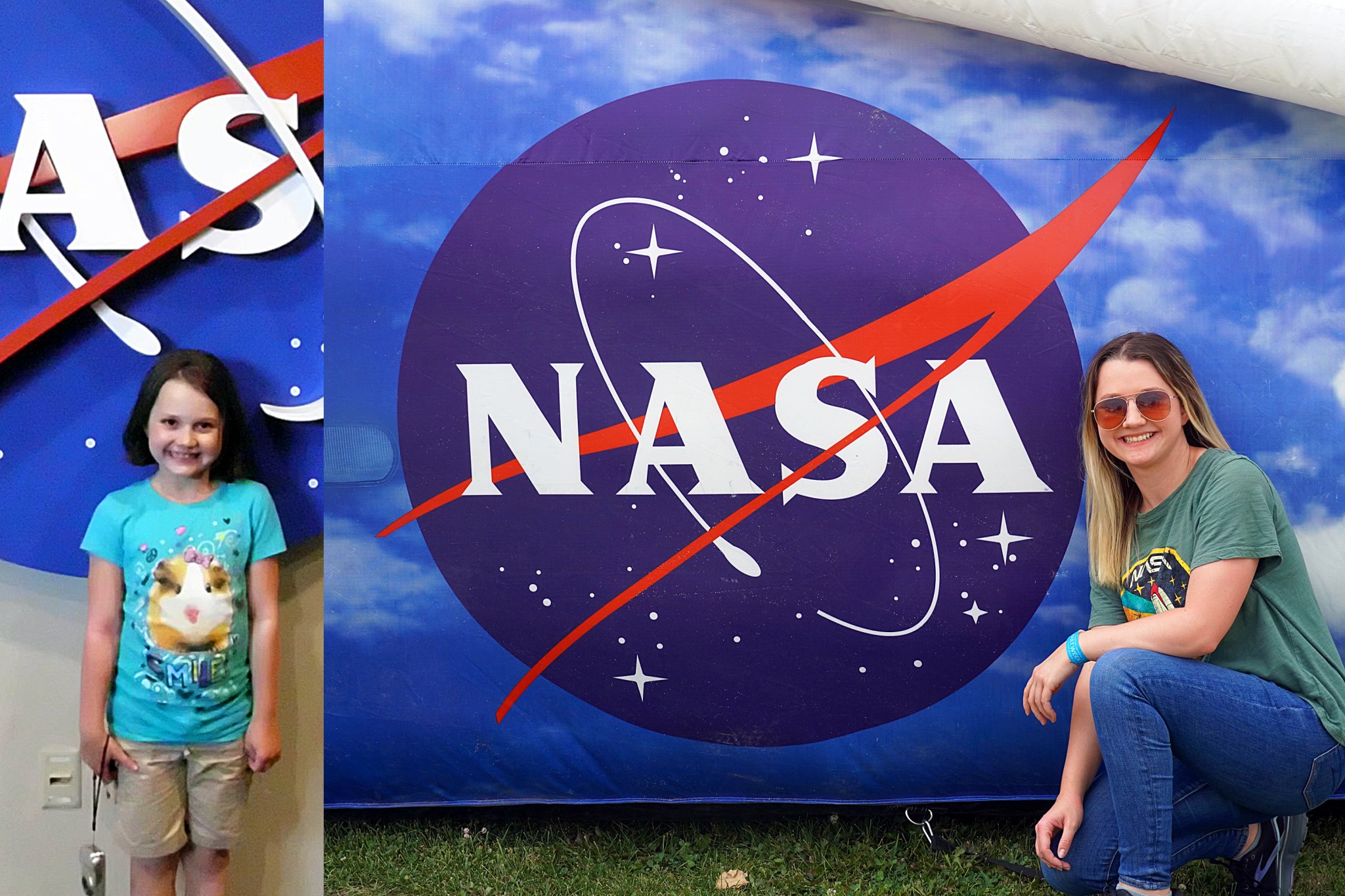
Happy National Intern Day! As you’ve seen today, our NASA interns took over our NASA Aeronautics social media to share their enthusiasm about aeronautics.
One of those interns is Sarah Freeman, a senior in mechanical and manufacturing engineering at Miami University in Oxford, Ohio. She is interning at NASA’s Glenn Research Center in Cleveland supporting the Electrified Power Flight Demonstration project.
She wrote an inspirational story about how and why she ended up as a NASA intern:
“From a young age, I was captivated by the sky and the stars beyond. When asked what I wanted to be when I grew up, I would respond: ‘I want to work for NASA.’
Growing up, I eagerly attended public outreach events hosted by NASA’s Glenn Research Center at the local library and science center in Cleveland. These events were more than just informative; they were inspirational, igniting my dreams and ambitions to one day contribute to the development of aviation.
My journey is not just about my personal dreams. I understand the importance of inspiring the next generation of scientists, engineers, and innovators, especially young girls and other underrepresented groups in STEM fields.
There is a special impact that representation can have on young minds and something very special about getting kids excited about science.
As I attend the EAA AirVenture Oshkosh airshow, I am helping run STEM events for children, from popsicle stick airplanes to marshmallow Martian helicopters, hoping to give back to an agency that supported my own growth and love for science.”
— John Gould
More from our Interns
Thursday, July 25 at 5:30 p.m. EDT
All Things Aviation
Thursday, July 25 at 4 p.m. EDT
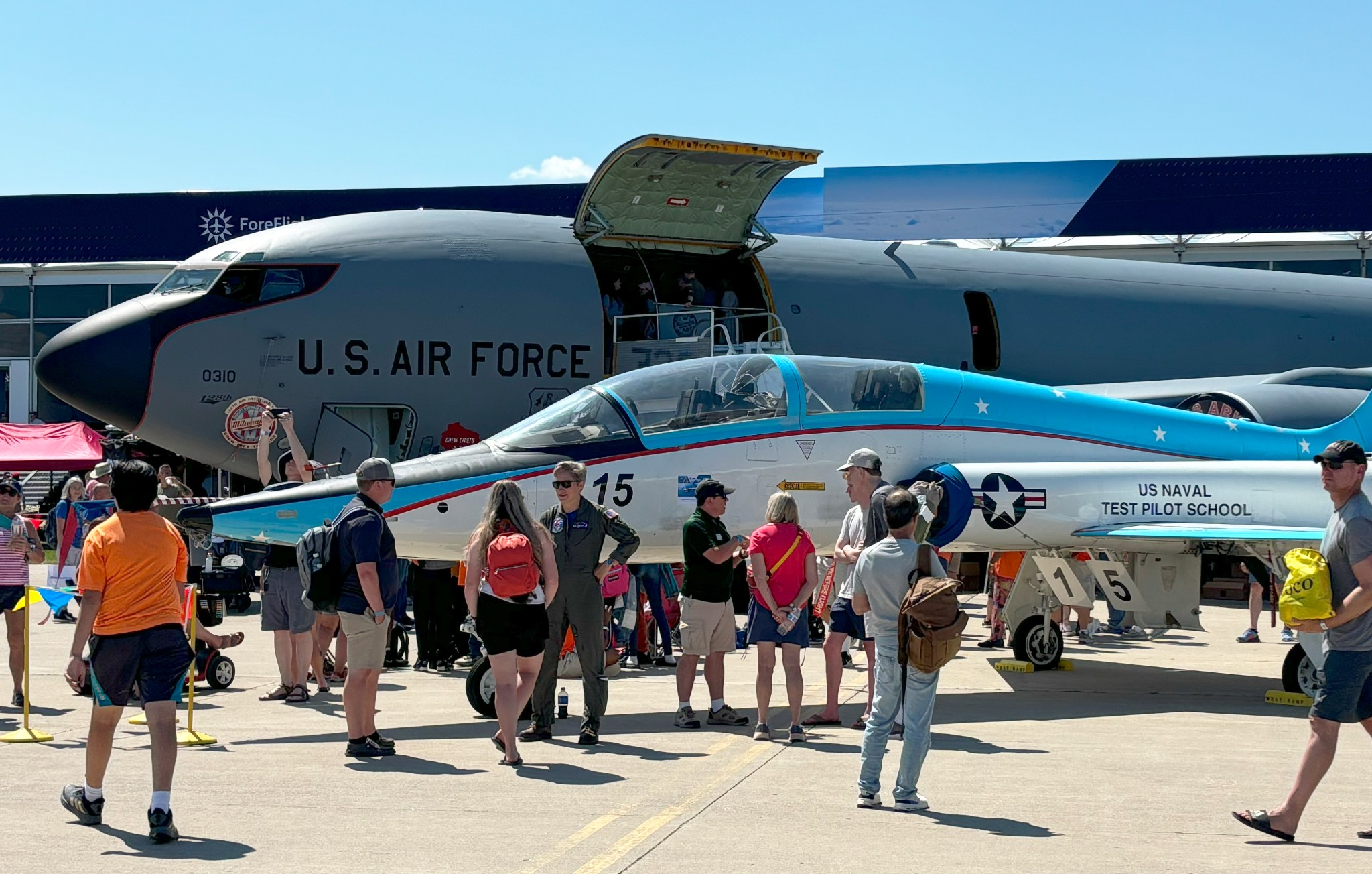
In covering all the awesome NASA activities at Oshkosh the past few days, a key piece of the story hasn’t been shared yet: the very spirit of airshows and fly-ins.
At the picnic tables during lunch, conversation on aviation abounds. Strangers are united by a deep passion for flying and strike up new friendships and bonds over where they came from, how they travelled here, and the meaning of aviation to their lives.
There are always airplanes in the sky no matter what time of day – airshow or not. Just a few examples of the aircraft that flew above us during lunch are a Harrier jump jet (which landed vertically, in style), a Bell 47 Helicopter, Ford Trimotor, B-29, two FA-18s, and a Cessna 172.
No matter what is flying overhead, most everybody looks up to admire the aircraft, whether it’s cutting-edge technology, military fighters, historic warbirds, or workhorses of general aviation.
In much the same way, we admire our NASA aircraft such as the F-15D and F/A-18 aircraft supporting the Quesst mission, the T-38s our astronauts fly, or the Super Guppy transporting large air and space hardware.
But what we really can’t wait for is the future: the X-59, X-66, and Advanced Air Mobility vehicles!
— John Gould
From Intern Catherine Russell
Thursday, July 25 at 3 p.m. EDT
From Intern Gavin Gardner
Thursday, July 25 at 1 p.m. EDT
Interns Tell the Story
Thursday, July 25 at Noon EDT
There’s been something of a shift change at the NASA Pavilion in that many of our volunteers who were there during the first half of the week have left, only to be replaced by a fresh group working the rest of the Oshkosh 2024 air show.
Among them are a group of NASA interns, each of whom have their own stories to tell and own perspective on what’s happening at Oshkosh. We’ll be featuring their posts to social media on this page throughout today, which is National Intern Day.
And if you’re at Oshkosh, come by the NASA Pavilion and say hi to the new folks.
— Jim Banke
Day 4 Begins
Thursday, July 25 at 10 a.m. EDT
Good morning from Oshkosh! Throughout the week, this departure board GIFs with the daily schedule of NASA events have been clicking on the big screens here in the NASA Pavilion, and on social media, so our guests know what’s on for the day.
Though today appears to be a lighter day in terms of panels, the Pavilion and KidVenture are open and full of visitors, as usual!
— John Gould
Final Fact on Day 3
Wednesday, July 24 at 8:30 p.m. EDT
Fun fact! During the week of EAA AirVenture Oshkosh, the number of takeoffs, landings, and airshow activities at the airport temporarily makes Oshkosh, Wisconsin the busiest airspace on the planet.
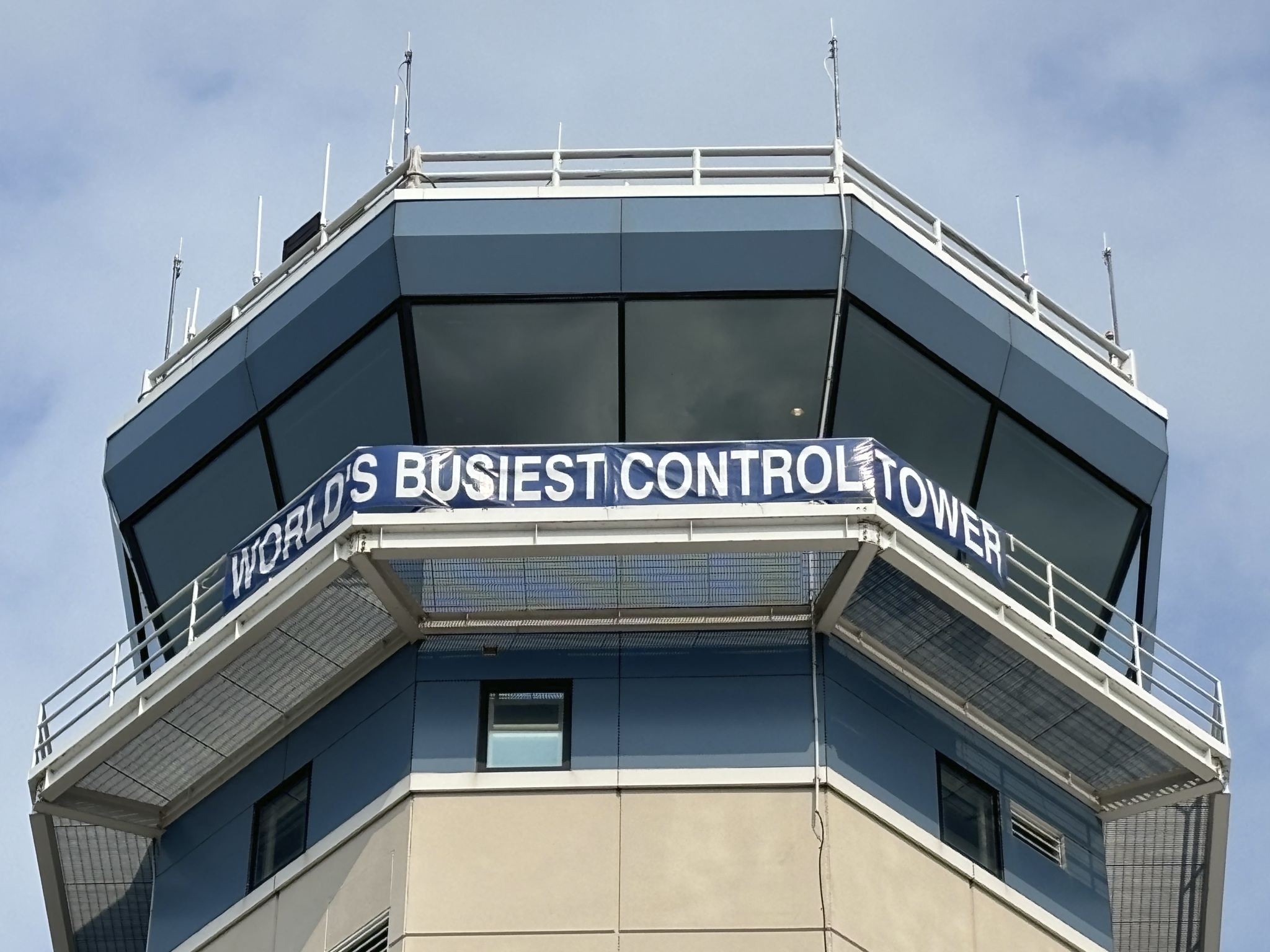
That’s a wrap on Day 3 of NASA’s activities! See you all tomorrow morning.
— John Gould
VIP Meet and Greet
Wednesday, July 23 at 7 p.m. EDT
It Takes All Jobs
Wednesday, July 24 at 5:30 p.m. EDT
Another panel today at Oshkosh titled “Unique Careers at NASA” expanded that career-advice subject into what some think of as “non-STEM STEM careers.”
What that means is there are plenty of people vital to NASA’s work who aren’t necessarily scientists, pilots, astronauts, or engineers. The panelists’ roles at NASA exemplify this diversity of thought and capability.
The panelists included:
- April Lanotte (moderator), STEM integration lead for NASA Aeronautics, former teacher.
- Dustin Hitt, engagement specialist for NASA’s Langley Research Center in Hampton, Virginia, former US Navy corpsman and civilian medic.
- Jessica Arreola, digital and public engagement lead for NASA Aeronautics.
- Andrew Carlsen, multimedia producer for NASA Aeronautics, former advertising producer and videographer.
- Carimanda Cephas, external stakeholder engagement lead for NASA Aeronautics, former crisis communications specialist.
- Robin Hertz, librarian at NASA’s Glenn Research Center in Cleveland, former teacher and historian.
The panel enthusiastically shared their unique journeys to NASA with the audience, which was comprised of kids, teenagers, and adults alike. They related how each of their roles at NASA is a combination of their passions and appreciation for STEM.
Pertz shared how as coming from a library and education background, she is not a pilot or astronaut, but is a research librarian for pilots and astronauts. Though she didn’t like math and science in school, it didn’t limit her opportunities, and has never looked back since joining NASA.
Arreola shared how bilingualism has been important to her career. Her first language is Spanish, which is helpful in public engagement events and creating original Spanish-language web content. She spoke about how discovering NASA had public affairs offices, and that she lived near a NASA center, inspired her to throw her hat in the ring, and she achieved that goal.
Cephas shared how it’s important to be an advocate for yourself. She recommends to students that if they have an interest, they should tell their teachers and parents about it and ask them for help exploring it.
Lanotte added how her experience being a teacher taught her how to juggle schedules, manage large groups of people, and communicate and be effective in stressful environments.
Hitt spoke about his experiences as a medic and in the Navy, and how he had a lifelong passion for flight. When an opportunity came up at NASA to be part of sharing that excitement with others, he jumped at the chance, and got to grow and achieve several different roles at the agency.
So if you’re not a scientist or engineer but want to be part of NASA, remember these stories!
— John Gould
Women at NASA Panel
Wednesday, July 24 at 4 p.m. EDT
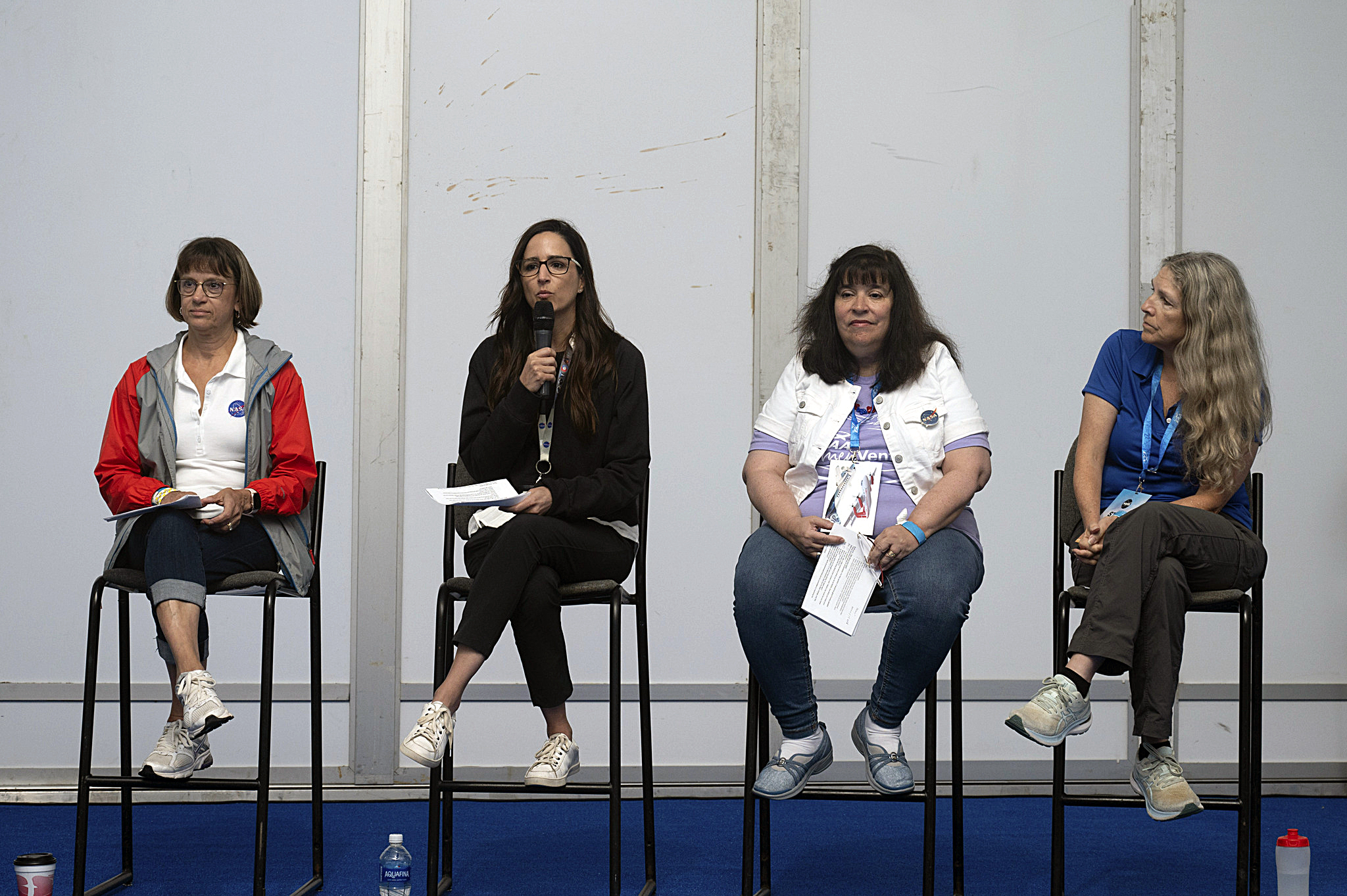
We kicked things off early this morning with the Women at NASA panel. Four inspiring women at NASA Aeronautics had an outstanding conversation about their careers, experiences, and advice for young people about pursuing a STEM leadership career!
The panel was comprised of:
- Barbara Esker, deputy associate administrator for Programs at NASA’s Aeronautics Mission Research Directorate
- Kate McMurtry, deputy director of the Integrated Aviation Systems Program
- Gaudy Bezos-O’Connor, manager of the Electrified Powertrain Flight Demonstration project
- Brenda Henderson, propulsion noise researcher at NASA’s Langley Research Center in Virginia
Panels like this exemplify what makes NASA’s presence at Oshkosh unique – here, you can witness experts offer insightful discussions on not just aviation, but also how to find your niche in STEM. That advice ranged from what to spend time on in college to developing emotional intelligence as a project manager.
But what drove all four panelists to end up in their line of work is the desire to make a difference in their passion – in this case, flight research.
Barbara Esker, for example, began her 35-year career at NASA as an engineer, and now has had the experience of seeing X-planes turn from ideas into real-life aircraft from leadership positions.
Esker related how through her career, she always wanted to make a difference wherever she was at – whether it was being on a team or leading a team. Then she started to get interested in how the budget works and higher-level operations. She told the audience to know that wherever they are in their careers, the opportunities will come.
Kate McMurtry added the advice that when someone tells you that you’re good at something, listen to them. She explained a couple of times she leaned into something she didn’t expect to be good at, but got selected for it, and the new role ended up being a good fit.
The whole panel emphasized that leadership isn’t just about the confidence of the leader – it’s also the leader’s ability to create the best environment for their team.
Gaudy Bezos-O’Connor described her experience of learning about herself so she could be more effective as a leader, and then, effective for her team. She said it’s important for leaders to keep learning and challenging themselves, and to do that with their team as well to provide an accepting culture to grow for each and every person.
Ultimately, what this all comes down to is making a difference and the mission of innovating new capabilities for aviation.
Brenda Henderson recommended an adventure spirit for those who dream of being a researcher. She explained how growing up in a small, rural town in Alaska, she had to have enough adventure within her to leave home, which later helped orient her to do innovative, challenging research.
A story from Bezos-O’Connor summarizes this idea. Her first job out of college was working at NASA Langley as a researcher. Following a devastating plane crash that had recently happened, she was on a team investigating how to prevent it happening again. She was tasked with innovating a way to simulate rain in a NASA wind tunnel – something not easily done.
On the first rig she tested, it wasn’t clear enough if the results were accurate, so she had to try something different. On the next rig, she leveraged some technology from the agricultural field, and got accurate results proving how to prevent that type of plane crash from happening again.
Her cross-disciplinary, innovative engineering approach with NASA made a difference. The results were given to the FAA, and the problem was fixed. Right out of college, she said, she had helped make a difference.
Crowds Keep Coming
Wednesday, July 24 at 1 p.m. EDT
Missed passing this cool fact along yesterday afternoon that visitors to the NASA Pavilion reached a milestone attendance figure — and the numbers keep growing today.
— Jim Banke
NASA STEM at Oshkosh
Wednesday, July 24 at 11 a.m. EDT
Yesterday, NASA test pilot Nils Larson spoke of the positive impact teachers have in their students’ lives. It inspired me to take a shuttle ride over to KidVenture, where NASA’s STEM educators have hands-on activities available for kids of all ages to enjoy and learn from.
One of the activities the kids gravitated towards involves throwing a paper airplane using a remote-controlled robot (an opportunity to learn about flight). Another exciting one is a robot soccer game (an opportunity to learn about planetary rovers).
It’s always inspiring to see a future aeronautical innovator’s eyes light up with fascination!
— John Gould
Still Busy on Day 3
Wednesday, July 24 at 9 a.m. EDT
Good morning from this, Day 3 of EAA AirVenture Oshkosh 2024. Here at Wittman Regional Airport, it’s currently overcast and chilly, but the sun is expected to come out just in time for the air show.
We have a packed day of NASA activities ahead of us! Stay tuned.
— John Gould
Day Two Wraps Up
Tuesday, July 23 at 8 p.m. EDT
There was a spot of rain here this afternoon, but the NASA Pavilion stayed busy! The skies cleared as the day drew to a close and we were treated to the sights (and sounds) of a number of warbirds in the sky – including a more modern F-22 flying by our tent, full afterburners on!
That brings us to the close of Day Two here at EAA AirVenture Oshkosh 2024. See you tomorrow for more coverage of NASA’s activities.
— John Gould
First Time Fly-In
Tuesday, July 23 at 5 p.m. EDT
There are many ways to get to Oshkosh, and one of the favorites is flying in! Each year, some NASA people join thousands of others by flying in their own airplane and camping out on the Oshkosh grounds.
Among them are NASA’s Kate McMurtry and her husband, Chris. Kate McMurtry is the deputy director of the Integrated Aviation Systems Program, which manages the X-59 and our other flight research aircraft.
Flying in their single-engine, two-seat Vans RV-7A airplane, they made their first trip to Oshkosh by air this year, a unique experience for pilots in terms of air traffic management.
“As you begin the approach to the airport, the area is so congested and the tempo extremely high, the interaction with Air Traffic Control is different than normal,” she said.
Instead of communicating via radio as would be normal for an approach, they relied on a “notice to airmen,” a set of flight operations information published in advance.
McMurtry said her favorite direction in the notice was to “Rock your wings” prior to getting cleared to enter approach to runway. The instruction – which has become a tradition for pilots coming into Oshkosh – involves gently tilting the aircraft back and forth as a signal.
“The congestion and the enthusiasm from Air Traffic Control applauding a ‘good rock’ and welcoming us to the show was an early indicator of the level of enthusiasm for this event. It was a thrill to land here.”
— John Gould
NASA Administrator Drops In
Tuesday, July 23 at 3:30 p.m. EDT
You never know who you may see here!
NASA Administrator Bill Nelson just paid a visit to the NASA Pavilion here. He toured all the exhibits, met with our Oshkosh team, and snapped some selfies with members of the public.
— John Gould
NASA Pilots Present
Tuesday, July 23 at 1:30 p.m. EDT
NASA pilots (and an astronaut!) spoke this morning to kids and families at the EAA AeroEducate tent. We already met pilots Nils Larson and Jim Less at yesterday’s X-59 panel, and joining them for this talk were Scott Howe, Bruce Milam, and retired NASA astronaut John Grunsfeld.
Howe also flies Advanced Air Mobility style drones and uncrewed aircraft systems in addition to traditional airplanes. He had some awesome thoughts about how flight research is a team effort.
“It’s not just about the pilots,” Howe said. “It’s truly a team effort. There’s a whole group of people on the ground working to make sure we can fly and do our missions. I love being part of that team.”
The group also told some inspiring stories about each of their journeys into being a pilot and joining NASA. Nils Larson gave a shoutout to the teachers in the room.
“Teachers have so much impact on peoples’ lives. My teacher handed me a book one day called ‘The Right Stuff. As I was reading it, I thought, this is cool!’ I knew then I wanted to be a pilot.”
“The Right Stuff,” of course, is an aviation and space community favorite written by Tom Wolfe, who chronicled the adventures (and cultural significance) of the early test pilots and astronauts.
— John Gould
A Two-Minute Tour
Tuesday, July 23 at 11 a.m. EDT
Be sure to give us a follow on social media for more coverage of Oshkosh 2024 and information about our aeronautics research!
Day Two Begins
Tuesday, July 23 at 10 a.m. EDT
Good morning from the NASA Pavilion at Oshkosh 2024! Before opening to the public, our team — which includes representatives from NASA’s aeronautics-focused field centers in California, Ohio, and Virginia — got in some morning stretches to wake up and refresh for another day of sharing the spirit of aeronautics.
— John Gould
Day One is History
Monday, July 22 at 10 p.m. EDT
The sun has set over Wittman Regional Airport, site of the EAA AirVenture Oshkosh 2024 air show as the first full day of activities comes to a close.
At the airshow’s Theater in the Woods venue, a tribute to the late Dick Rutan is taking place. In 1986, the legendary pilot, along with crewmate Jeana Yeager, was the first to fly an airplane non-stop around the world without stopping for fuel. Rutan died in May.
Meanwhile, thousands of pilots and their friends and families are retiring to campsites next to the parked airplanes they flew to the airfield for the event – a staple of the Oshkosh experience.
Looking ahead to Tuesday, the highlight of the day from NASA’s perspective will be the attendance of Bill Nelson, the agency’s administrator. He is making his first visit to the airshow. Among his plans: He’ll get an up-close look at some historic aircraft and visit the NASA pavilion.
We’ll continue to post updates throughout the day. Thanks for checking in today.
— Jim Banke
Aviation’s Sustainable Future
Monday, July 22 at 7:30 p.m. EDT
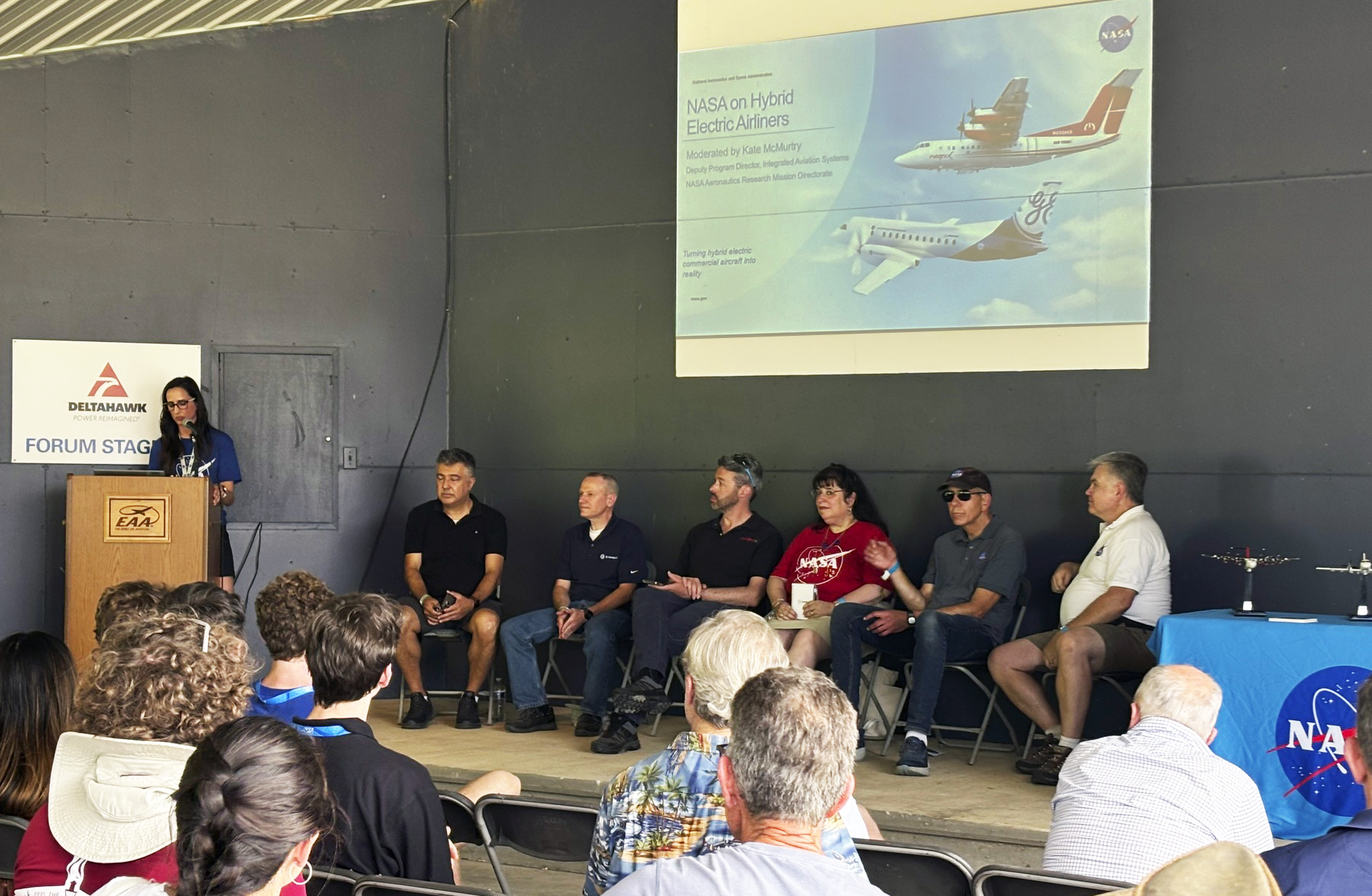
This afternoon NASA hosted its final panel of the day. “NASA on Hybrid Electric Airliners” focused on our efforts in researching sustainable aviation technologies and practices.
Four NASA experts on the panel were joined by representatives from GE Aerospace, magniX, and the University of Wisconsin – all who are working with NASA on this research activity.
The panelists discussed both hybrid-electric and fully electric aircraft. This included talking about a project that is focusing on developing a hybrid-electric, small-core jet engine that could significantly reduce fuel consumption.
NASA also is developing two aircraft in collaboration with GE Aerospace and magniX – a modified Saab 340B and De Havilland Dash 7, respectively – to demonstrate megawatt-class electrified powertrains and other systems.
It’s all part of NASA’s Sustainable Flight National Partnership, which is a collaboration between government, industry, and academia to achieve net zero greenhouse gas emissions from aviation by 2050. The projects mentioned above aim to have their technologies available to industry during the 2030 to meet that goal.
The speakers shared not just their knowledge, but also their enthusiasm for sustainable aviation and its future.
NASA’s Mark Turner encouraged the audience to come visit him in the NASA Pavilion afterwards to continue an engaging conversation on the nuts-and-bolts details of how NASA’s hybrid-electric engine core concept works.
The panel also shared admiration for the next generation of aeronautical engineers:
— John “We’re at the precipice of a transformation in aviation’s future,” said Gaudy Bezos-O’Connor, manager of the Electrified Powertrain Flight Demonstration project. “With this collaboration between government, academia, and industry I think we can make that 2050 goal. There are challenges, but we have smart and talented people in this generation that’s coming up, and we really can change the way aircraft of the future are designed, built, and flown.”
— John Gould
NASA's Quesst Mission Panel
Monday, July 22 at 4:30 p.m. EDT
During the first NASA panel this week, NASA test pilots Nils Larson and Jim Less talked to a huge crowd about the supersonic X-59 quiet supersonic experimental aircraft, which is preparing for its first flight. Both pilots have worked on the development of the airplane for several years and know its systems inside and out.
They began the talk by discussing their careers in aviation and how they came to fly for NASA. Larson, for example, was once a U-2 pilot, and Less once flew F-117 fighter jets. The X-59, however, is much different than the types of aircraft they flew before.
As the centerpiece for NASA’s Quesst mission, the X-59’s unique shape is designed to quiet the typical sonic booms associated with supersonic flight and perhaps help lift the half-century ban on faster-than-sound commercial air travel over land.
“We’re trying to turn the boom into a thump – to turn the speed limit into a sound limit,” said Less.
Larsen and Less described to the aviation-enthusiast audience the X-59’s design, how the Quesst mission will fly the X-59 over select communities to gauge community response to its quieter sound, as well as some of the aircraft’s quirks and features.
One of those features: The X-59 doesn’t have a forward-facing window. Instead, the pilots will see what is directly in front of them using the eXternal Vision System – a collection of high-definition cameras and other data sources feeding a 4K monitor located in the cockpit.
Read more about NASA’s Quesst mission.
— John Gould
Meeting NASA's X-59 Pilots
Monday, July 22 at 2:30 p.m. EDT
Visitors to the NASA Pavilion are finding plenty to do during this first full day of the airshow. Activities inside include collecting informational handouts, trying out a flight simulator, and chatting with NASA researchers and engineers.
A popular attraction today is the opportunity to meet the two NASA test pilots who will be flying the X-59 quiet supersonic technology demonstrator. Jim Less (left) and Nils Larson are seen below meeting Oshkosh attendees and signing autographs.
They also participated in a panel today about NASA’s Quesst mission, which will use the X-59 to gather information for federal and international regulators that could lead to enabling commercial faster-than-sound air travel over land.
— John Gould
NASA at Oshkosh Open for Business
Monday, July 22 at 11:30 a.m. EDT
Welcome to NASA’s web coverage of EAA AirVenture Oshkosh 2024.
It’s a bright, sunny, and warm day here in Wisconsin. There are airplanes of all types taking to the skies above us, and many more parked on the airport grounds.
Oshkosh is the largest fly in and airshow in the world. More than half a million people are expected to attend and celebrate the spirit of aviation.
NASA is here too and involved in all kinds of ways. The NASA Pavilion – center of NASA-related activities – is now open for the week and already is full of visitors!
To learn more about NASA’s involvement this week, read our preview story.
— John Gould
NASA Aeronautics Returns to Oshkosh
Sunday, July 21 at 8:30 p.m. EDT
NASA will appear at Oshkosh with a full slate of interactive exhibits, informative activities, and fascinating people to meet. But if you can’t make it we’ve got you covered. Enjoy the show virtually right here on this page. John Gould will be onsite this coming week sending in daily updates with news about NASA’s events and festivities. Our goal is to give you our best “you are there” experience. Just with no cheese curds.
— Jim Banke





























